Vol. 69, No. 9 (2020)
2020-05-05
INVITED REVIEW
COVER ARTICLE
INVITED REVIEW
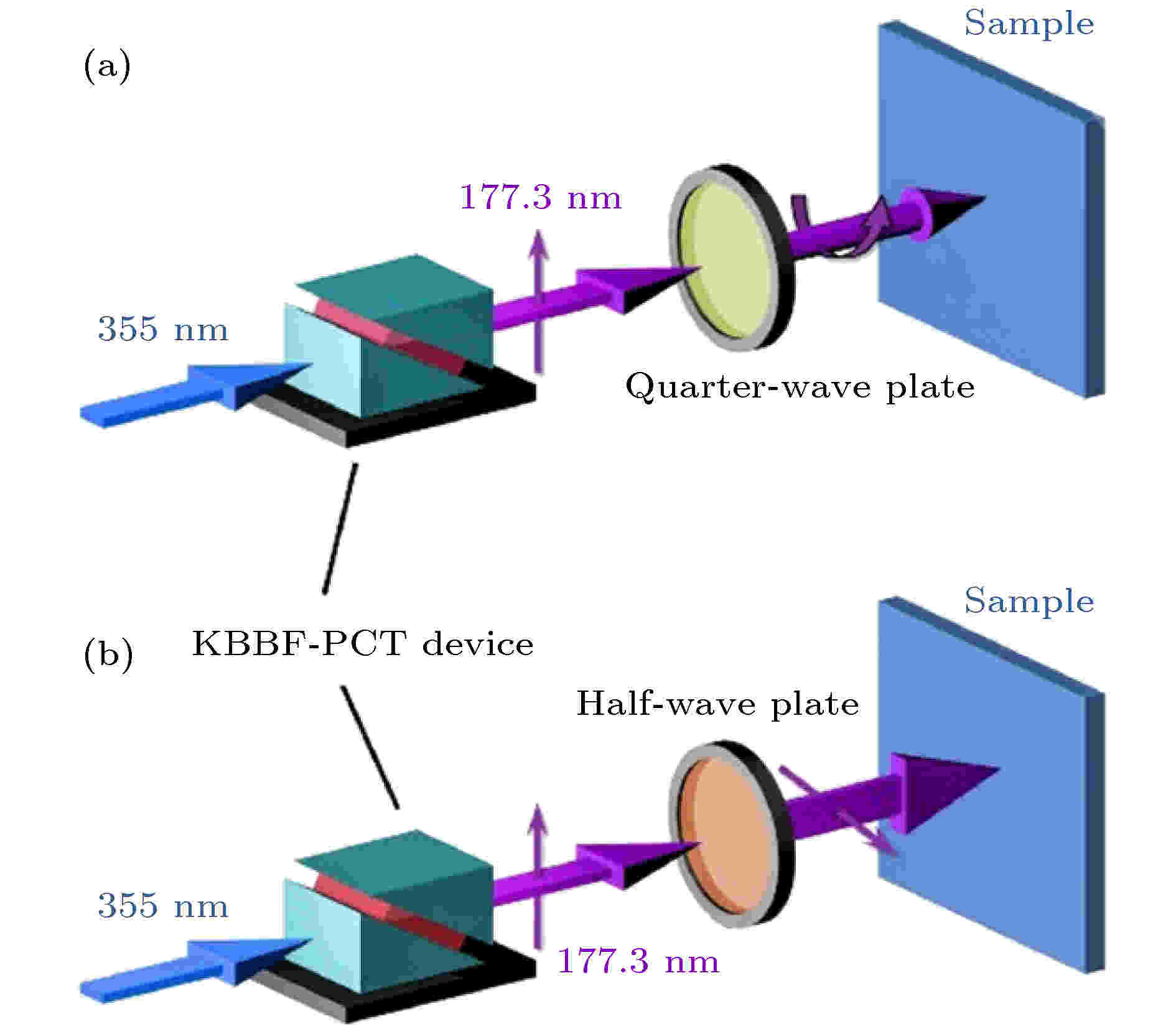
COVER ARTICLE
2020, 69 (9): 096801.
doi:10.7498/aps.69.20200083
Abstract +
Magnetic imaging technology based on photo-emission electron microscopy (PEEM) has become an important and powerful tool for observing the magnetic domain in spintronics. The PEEM can get access to real-time imaging with high spatial resolution and is greatly sensitive to the spectroscopic information directly from the magnetic films and surfaces through photoemission process with variable excitation sources. Moreover, the breakthrough in the deep ultraviolet (DUV) laser technology makes it possible to realize domain imaging without the limitation of synchrotron radiation facilities or the direct excitation of photoelectrons due to the high enough photon energy of the source in the current threshold excitation study. In this review article, the deep ultraviolet photo-emission electron microscopy system is first introduced briefly. Then, a detailed study of the magnetic domain observation for the surface of L10-FePt films by the DUV-PEEM technique is presented, where a spatial resolution as high as 43.2 nm is successfully achieved. The above results clearly indicate that the DUV-PEEM reaches a level equivalent to the level reached by X-ray photoemission imaging technique. Finally, a series of recent progress of perpendicular FePt magnetic thin films obtained by the DUV-PEEM technique is provided in detail. For example, a stepped Cr seeding layer is used to form the large-area epitaxial FePt films with (001) and (111) two orientations, where magnetic linear dichroism (MLD) with large asymmetry is observed in the transition area of two phases. The signal of MLD is 4.6 times larger than that of magnetic circular dichroism. These results demonstrate that the magnetic imaging technology based on DUV-PEEM with excellent resolution ability will potentially become an important method to study magnetic materials in the future.
REVIEW
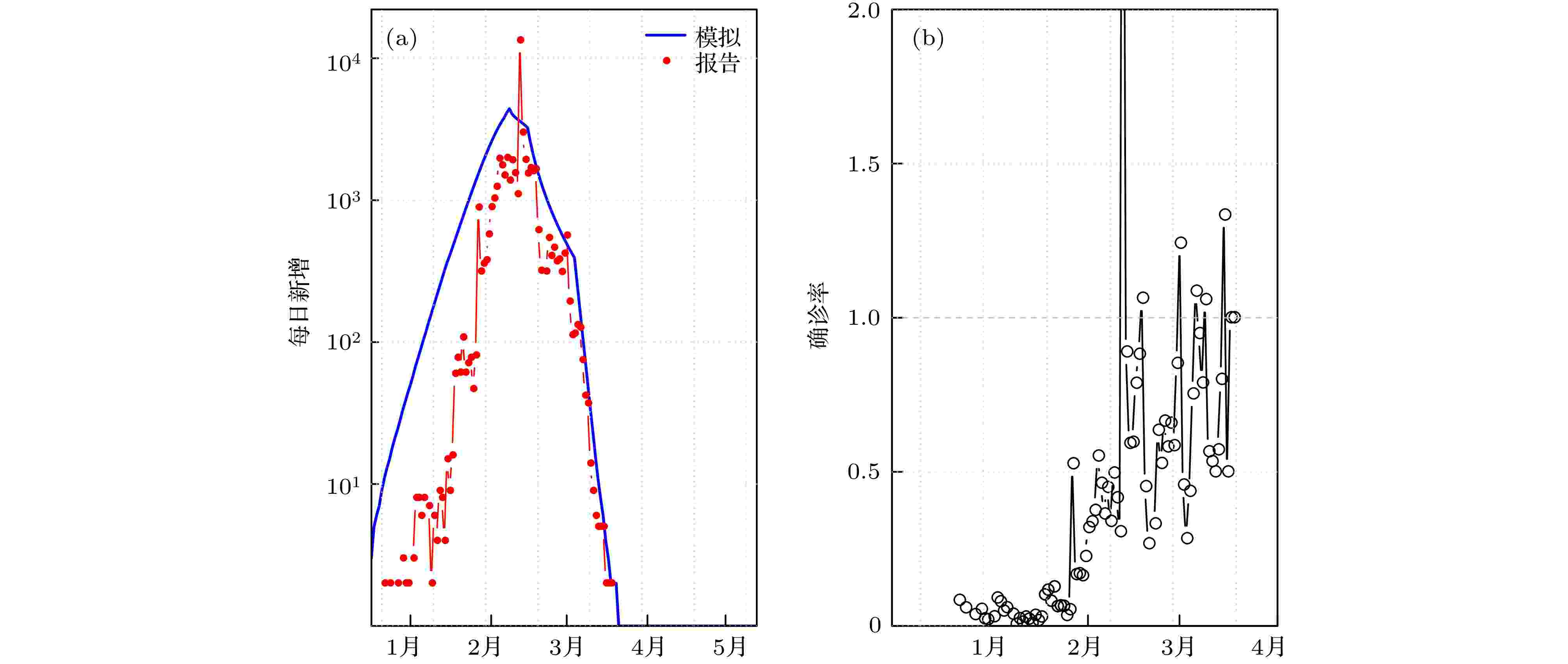
2020, 69 (9): 090202.
doi:10.7498/aps.69.20200389
Abstract +
The coronavirus disease 2019 (COVID-19) has become a major public health concern internationally. To capture the epidemic growing patterns and quantify the transmissibility, some key epidemiological parameters and dynamic models are of significance for helping us to understand the features of COVID-19 and thus informing the strategic decision-making in combating the outbreak. In this study, we review and summarize the recently released research results about the reproduction numbers, incubation period and serial interval of COVID-19. We summarize the estimates as well as estimation approaches adopted to calculate these epidemiological parameters in the existing literature. These studies found that the basic reproduction number is estimated at 2.6, the mean incubation period at about 5.0 days, and the mean serial interval at about 5.5 days. The COVID-19 infections can increase rapidly if it is not controlled. The control measures including the isolation, quarantine, contact tracing, improvement of public awareness, and adoption of self-protection measures can effectively mitigate the COVID-19 outbreak.
GENERAL
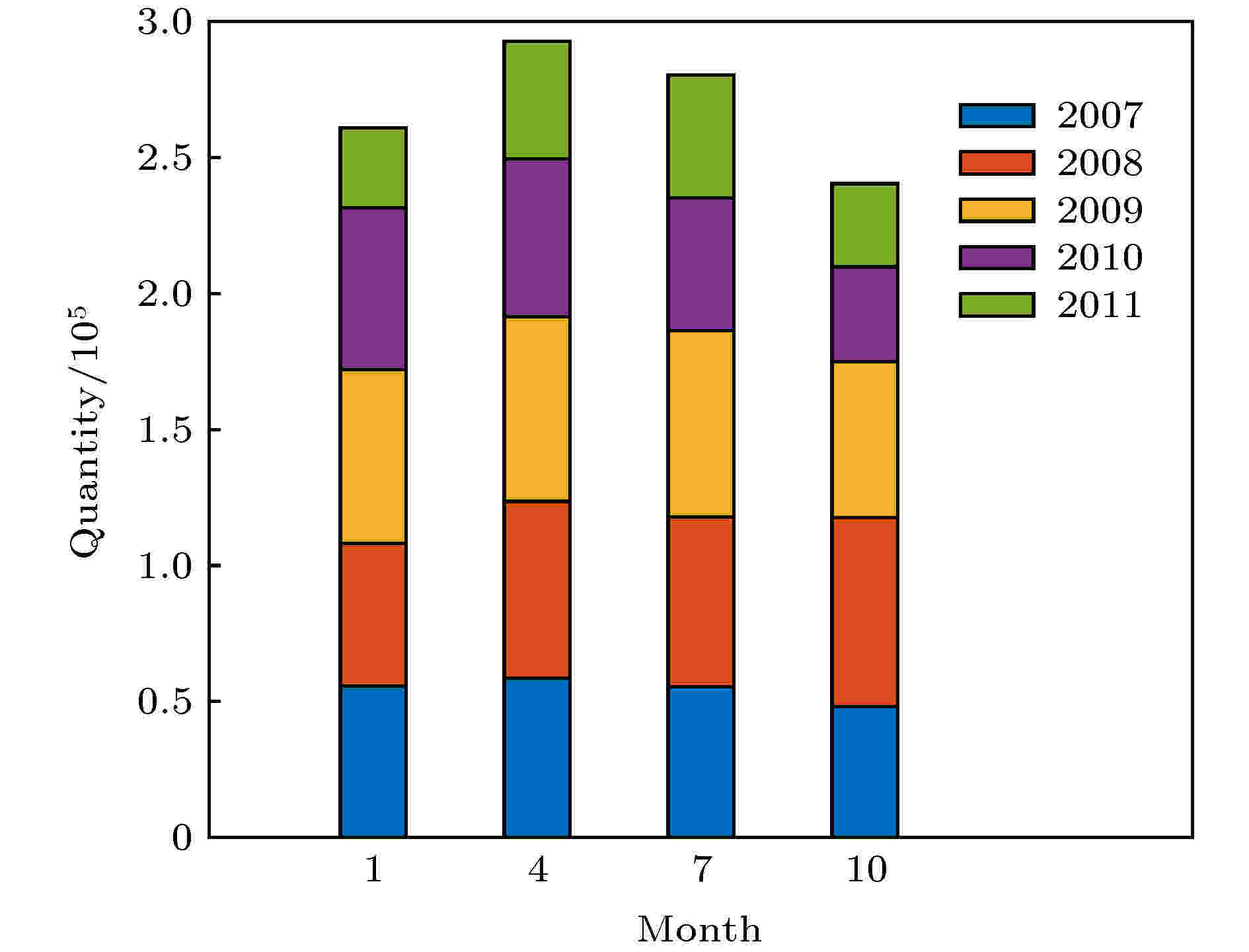
2020, 69 (9): 090201.
doi:10.7498/aps.69.20191992
Abstract +
In this paper, we propose a new method of numerical differentiation to determine the height of the top layer of the atmospheric boundary layer. In this method, a regularization technique is used to convert the problem of calculating the differential of the curve of the corners into the problem of finding the minimum value of the objective function. The two-parameter model function method is used to select the regularization parameters. Finally, the maximum gradient method is used to determine the top height of the boundary layer. Firstly, the effectiveness of the new method is validated through two numerical experiments. The experimental results show that as the noise of the occultation data increases, the fluctuation of the height of the boundary layer top obtained by the difference method and the numerical differentiation method combined with the L curve scheme increases. And the height obtained by the two-parameter model function method is very stable, which shows that the new method can filter the noise well, thereby retaining the main information about the profile. Then, based on the COSMIC angle data in January, April, July and October 2007-2011, the new method is used to analyze the seasonal characteristics of the height of the global oceanic and atmospheric boundary layer, compared with the seasonal distribution obtained by “zbalmax” with the occultation data. The results show that the seasonal distribution characteristics of the two data are very consistent: the height of the boundary layer is higher in the area where the sea surface temperature is higher than that in the surrounding sea area; on the contrary, the height of the boundary layer top is lower. In the sea area where the warm current passes, the height of the boundary layer is higher; in the sea area where the cold current passes, the height of the boundary layer is lower.

2020, 69 (9): 090203.
doi:10.7498/aps.69.20200503
Abstract +
Based on the information about more than 800 cases reported by Anhui provincial health commission on February 19 2020, the directional transmission relationship between the confirmed patients is constructed according to the contact history published in the cases, and it is found that the majority of the patients who can infect others are male and most of the patients who are infected are female. According to the analysis of case information, the early confirmed coronavirus disease 2019 (COVID-19) cases in Anhui province had the history of residence or exposure in Wuhan. In the later stage, the cases spread in small communities mainly by local transmission, and the strict prevention and control measures can effectively cut off further transmission in the communities. The time interval between diagnosing the source-infected patients and infected patients is fitted byΓdistribution, with a median of 2 days and an average of 2.67 days. Based on the statistical characteristics of directional transmission relationship, an autoregressive transmission model is constructed in the late stage of epidemic development in Anhui province, and the simulation results are consistent with the epidemic development data. Autoregressive model and simulation are also used for predicting the data of confirmed cases in the whole country except for Hubei province. This discovery can be referenced by regional epidemic prevention and control except for where it originated. Through strict protection measures and isolation measures, the spread of the epidemic outside the original place is highly viscous. It usually spreads by close contact between family members, and the local spread of COVID-19 can be effectively controlled.
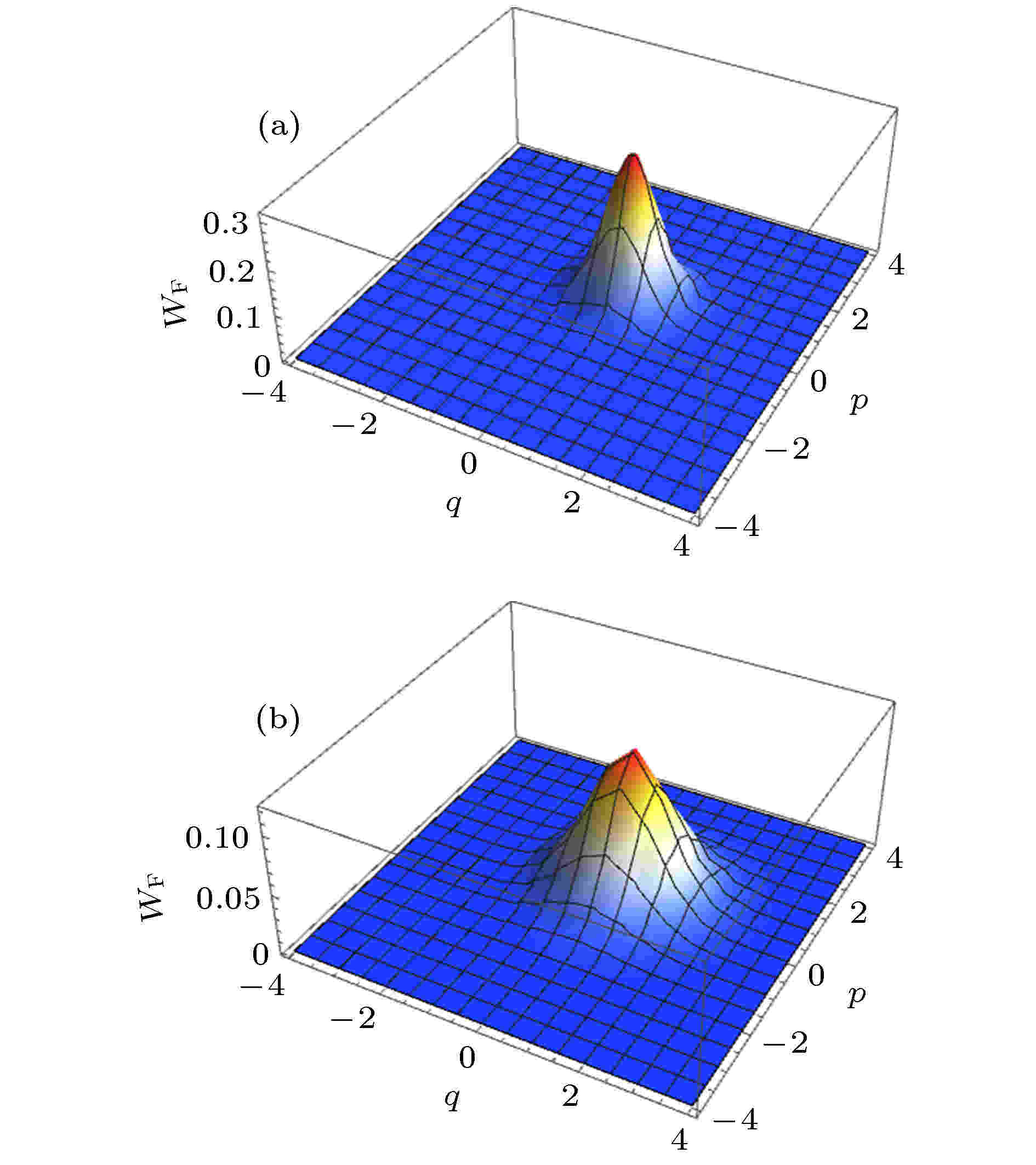
2020, 69 (9): 090301.
doi:10.7498/aps.69.20200106
Abstract +
As is well known, the evolution of quantum state can be replaced by its Wigner function’s time evolution. The Wigner function of a quantum state is the same as the density matrix of a quantum state, because they both contain many messages, such as the probability distribution and phases. Thus, the important information about the quantum state in the evolution process can be obtained more quickly and effectively by studying the Wigner function of a quantum state. In this paper, based on the classical diffusion equation, the diffusion equation of the quantum state density operator is derived by using thePrepresentation of the density operator. Furthermore, by introducing the Weyl ordering symbol of the quantum operator, the corresponding Weyl quantization scheme is given. In addition, the evolution equation of Wigner operator in diffusion channel is established by using another phase space representation of density operator—Wigner function, and the solution form of Wigner operator is given. In this paper, we derive the evolution law of Wigner operator in quantum diffusion channel for the first time, that is, the form of Wigner operator at any time in the evolution process. Based on this conclusion, the evolution of coherent states through quantum diffusion channels is discussed.
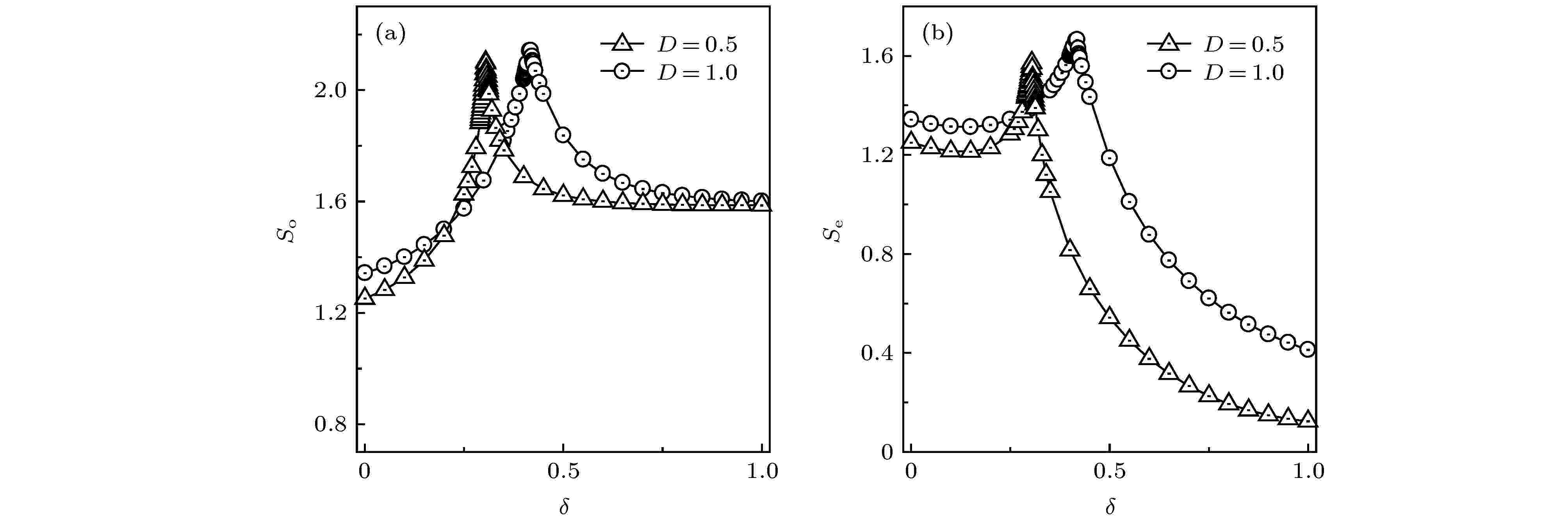
2020, 69 (9): 090302.
doi:10.7498/aps.69.20191773
Abstract +

EDITOR'S SUGGESTION
2020, 69 (9): 090303.
doi:10.7498/aps.69.20200040
Abstract +
As a crucial quantum resource in quantum information processing, multipartite entanglement plays an important role not only in the field of testing basic quantum effects, but also in the applications of quantum network, quantum communication and quantum computing. The generation of multipartite entanglement usually involves many complex linear processes and nonlinear processes. In this paper, we theoretically propose a scheme for generating genuine quadripartite entanglement by linking two independent four-wave mixing (FWM) processes with one linear beam splitter (BS). Here, we use one linear BS to mix the probe beams amplified by two independent FWM processes. We first set the transmissivity of the linear BS to be 0.5 and study the effect of the intensity gain of the system on quadripartite entanglement by applying the positivity under partial transposition (PPT) criterion. The results show that there exists genuine quadripartite entanglement in all gain regions, and the degree of entanglement increases with intensity gain increasing. And then, the dependence of quadripartite entanglement on the transmissivity of the linear BS is studied when the intensity gains of two independent FWM processes are both set to be 3. We find that the transmissivity of the linear BS can affect the entanglement properties of the system. At the same time, we also find that the system can generate genuine quadripartite entanglement when the transmissivity of the linear BS is not equal to 0 or 1. Finally, in order to reveal the entanglement structure of the system, we further investigate the dependence of the possible tripartite entanglement and bipartite entanglement on the intensity gain of the system by using the PPT criterion. The results show that there exists the genuine tripartite entanglement in this system, and the degree of entanglement increases as the intensity gain increases. However, there exists no genuine bipartite entanglement in this system, some of bipartite states are always separable, and the entanglement of the other bipartite states gradually become weak and eventually disappear with the increase of the intensity gain. Our theoretical result provides a simple and reliable scheme for generating genuine quadripartite entanglement by using FWM process in atomic ensemble and linear BS.
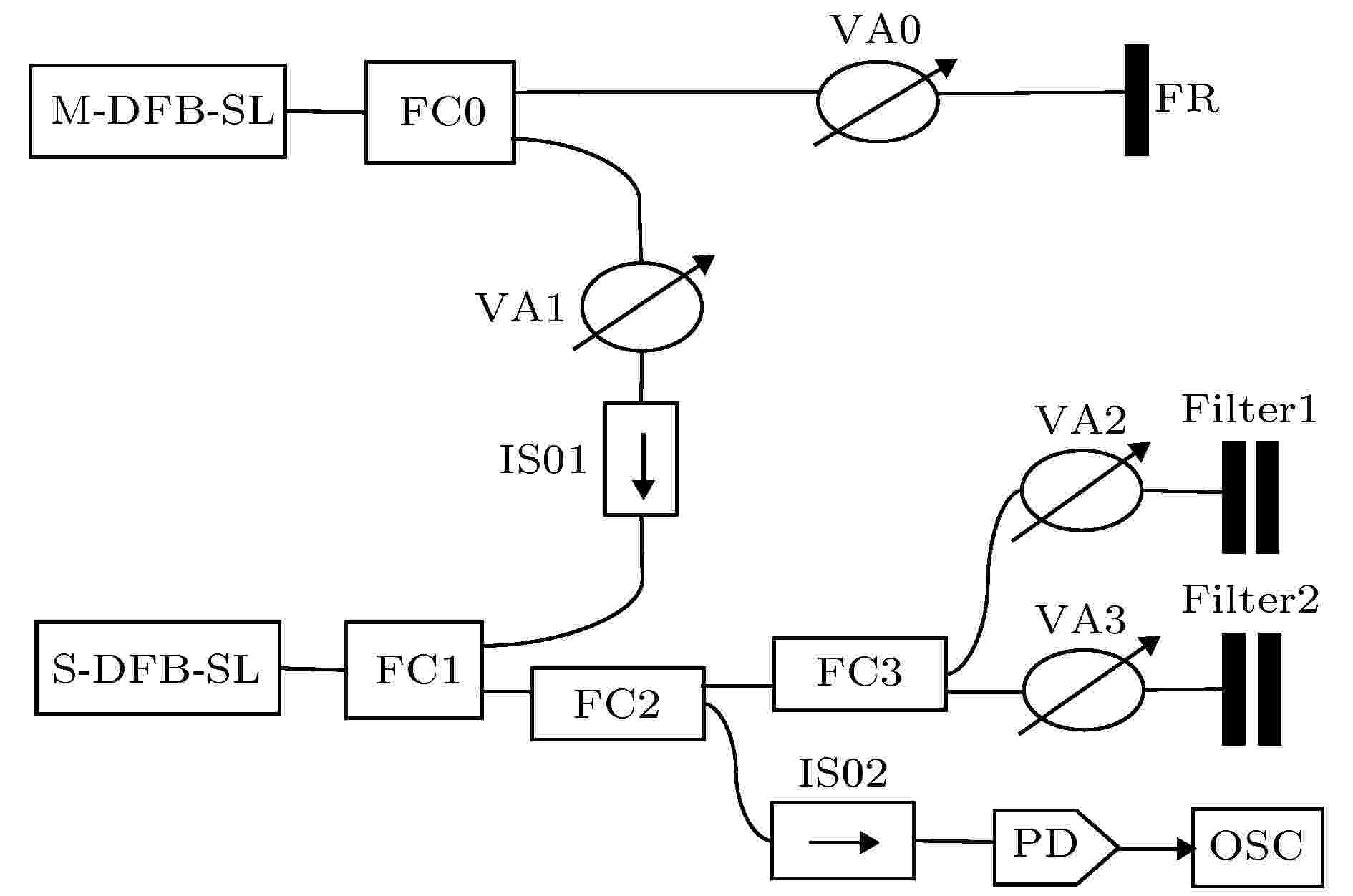
2020, 69 (9): 090501.
doi:10.7498/aps.69.20191881
Abstract +
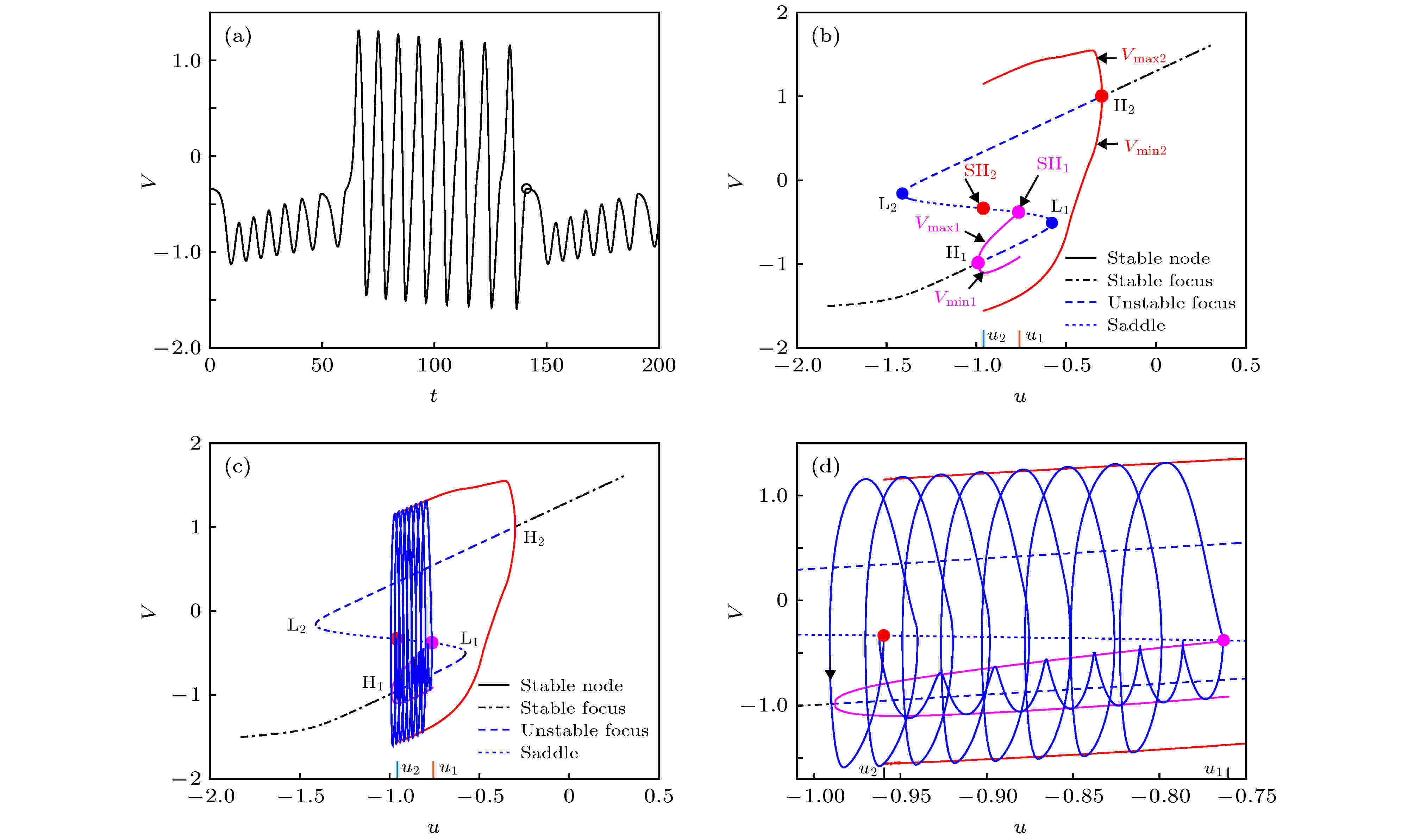
2020, 69 (9): 090502.
doi:10.7498/aps.69.20191709
Abstract +
Excitatory and inhibitory effect always induces the enhancement and inhibitory effect of neural electronic activities, which is the common viewpoint of the modulations to the neural firing and plays important roles in the information processing of the nervous system. In the present paper, the Homoclinic/Homoclinic bursting pattern with alternation behavior between burst containing multiple spikes and subthreshold oscillations and the tough value of the burst lower than that of the subthreshold oscillations is chosen as representative, and the excitatory effect on the complex nonlinear dynamics of the representative bursting pattern is studied. For the excitatory autapse with suitable autaptic time delay and strength, the autaptic current pulse applied to the trough of the burst can induce the number of spikes within a burst to decrease and then the average firing frequency to decline, which presents a novel example different from the common viewpoint of the excitatory effect. The excitatory autapse induces the average firing frequency to increase in the remained parameter region of two-parameter plane of the autaptic time delay and strength. With bifurcations acquired by the fast/slow variable dissection method and phase trajectory, the subthreshold oscillations of the bursting correspond to a subthreshold limit cycle of the fast subsystem and the spike within burst corresponds to a suprathreshold limit cycle, and excitatory autaptic current can induce the transition from suprathreshold limit cycle to subthreshold limit cycle, which leads the spike to terminate in advance and is the cause for reducing the average firing frequency. The results is the present paper are compared with the phenomenon and bifurcation mechanism that the excitatory autapse can induce the spike number to decrease within a burst but the average firing frequency to increase as indicated in a recent study on the Fold/Homoclinic bursting. These results enrich the uncommon phenomenon of the neuronal electrical activities, reveal the underlying nonlinear mechanism, provide a new way to regulate the bursting pattern, and disclose the potential functions of the excitatory autapse.

2020, 69 (9): 090601.
doi:10.7498/aps.69.20200081
Abstract +
To explore a new generation of ranging method suitable for industrial applications, in this paper, a spectral interferometry ranging method based on electro-optic (EO) comb is proposed. The mathematical model of EO comb and the principle of spectral expansion are analyzed in detail. Besides, the factors affecting the non-ambiguous range and resolution of the spectral interferometry method are also discussed. According to the theoretical analysis, the resolution of spectral interference ranging is mainly affected by the spectrum width of the optical frequency comb, and the non-ambiguous range is affected by the resolution of the optical spectrum analyzer (equal to the highest sampling rate of the optical spectrum analyzer). In the experiment, triple cascaded EO phase modulator is used to modulate a single frequency laser to generate more than 40 high-power sidebands. Then, the laser spectrum output from the EO modulator is expanded by single mode fiber and high nonlinearity fiber. Owing to the use of erbium doped fiber amplifier between the dispersion compensation fiber (single mode fiber) and the highly nonlinearity fiber, the polarization disturbance does not affect the spectrum width of the optical frequency comb significantly. However, the width of spectrum will be still affected by the phases of light, and the phases of light can be adjusted by the phase shifters in the front of the electro-optic modulators. Finally, the EO comb with a repetition frequency of 10 GHz and spectrum width of 30 nm is obtained. The EO comb can be used as the source of spectral interferometry scheme. Since the repetition frequency of the EO comb is high enough, which can meet the distortion-free sampling of optical spectrum analyzer. Hence, there is no “dead zone” in the measurement range. Besides, the equal frequency interval resampling algorithm and quadratic equation fitting algorithm are used in the data processing. Through the use of these algorithms, we can eliminate the measurement errors caused by non-equal frequency interval sampling of the optical spectrum analyzer and improve the ranging accuracy. The experimental results show that within the range of 1 m, the absolute ranging accuracy of 15 μm can be achieved at arbitrary position.

2020, 69 (9): 090701.
doi:10.7498/aps.69.20200153
Abstract +
ATOMIC AND MOLECULAR PHYSICS
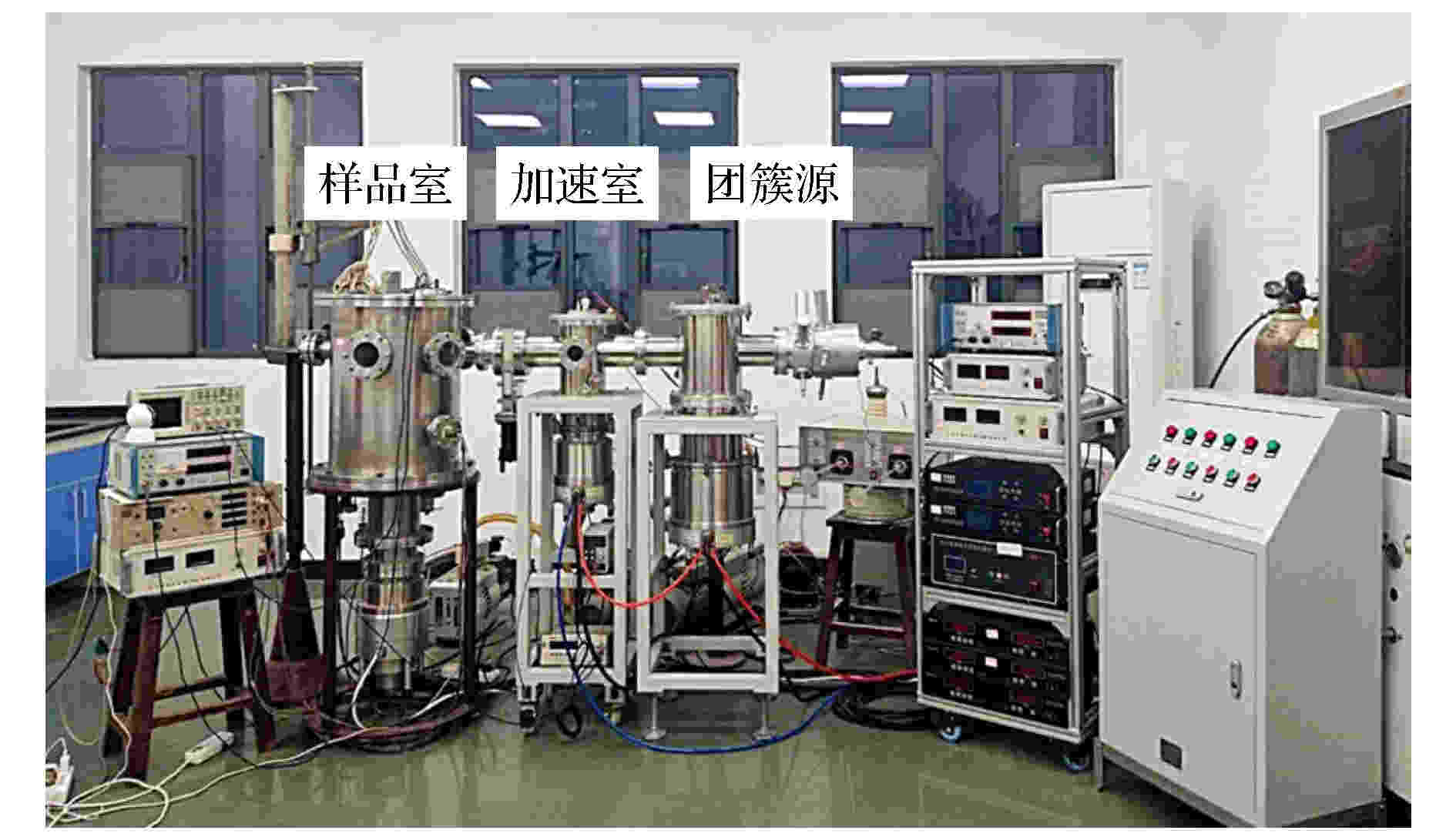
Design and application of gas cluster accelerator for surface smoothing and nanostructures formation
2020, 69 (9): 093601.
doi:10.7498/aps.69.20191990
Abstract +
A custom-built gas cluster ion source with energy up to 50 keV is constructed, and Ar, CO2, N2, and O2are used as the working gases. The clusters are formed by a metal supersonic conical nozzle with critical diameter in a range of 65–135 μm and a cone angle of 14°. The nozzle is powered in the pulsed mode, which improves the pumping conditions, and also makes it possible to increase the gas pressure in the stagnation zone to 15 atm and thereby obtain larger clusters. Based on the principle of ultrasonic expansion, gas cluster ions with an average size of 3000 atoms are obtained. The cluster beam current of 50 μA is obtained. The Ar cluster beam, which is less reactive, is used for treating surface, namely, surface smoothing and formation of self-assembled nanostructures. The Ar cluster bombardment perpendicular to the surface of the substrate is used to demonstrate the smoothing of the surface of Si wafers, Ti coating, and Au film. For the initial Si wafer, its root-mean-square (RMS) roughness of 1.92 nm decreases down to 0.5 nm after cluster beam treatment. The cleaning effect of the cluster beam is also observed very well. The one-dimensional (1D) isotropic power spectral density of the Si surface topography before and after smoothing are also discussed. The off-normal irradiation Ar cluster beam is also used to form self-assembled surface nanoripple arrays on the surface of flat ZnO single crystal substrates. The ripple formation is observed when the incident angle of the cluster beam is in a range of 30°–60°. The process of nanoripple fabrication is significantly governed by the cluster beam incident angle, energy and dose. The nano-ripples formed on the flat substrates remain eolian sand ripples and their formation starts at the incident angle of 30°. The most developed nanoripples are observed at the incident angle within a range of 45°–60°. The surface morphology and characteristic distribution of the nano-structures on the flat ZnO substrate are also analyzed by the two-dimensional (2D) power spectral density function. Next, Ar cluster beam is used for irradiating the ZnO nanorod arrays grown on the Si substrate. Due to various angles between the nanorod’s axis and the substrate normal, the conditions of the ripple formation on the nanorod facets are also realized. The dependence of wavelength on the accelerating voltage of the cluster ions and the dose are studied. Similar dependence of wavelength on accelerating voltage and dose are found for nanorods. Comparing with the flat ZnO surface, nanoripples on the ZnO nanorod faces at high irradiation doses demonstrate an ordering effect, and morphology of the ripples resembles that of more parallel steps rather than eolian ripples.
ELECTROMAGNETISM, OPTICS, ACOUSTICS, HEAT TRANSFER, CLASSICAL MECHANICS, AND FLUID DYNAMICS
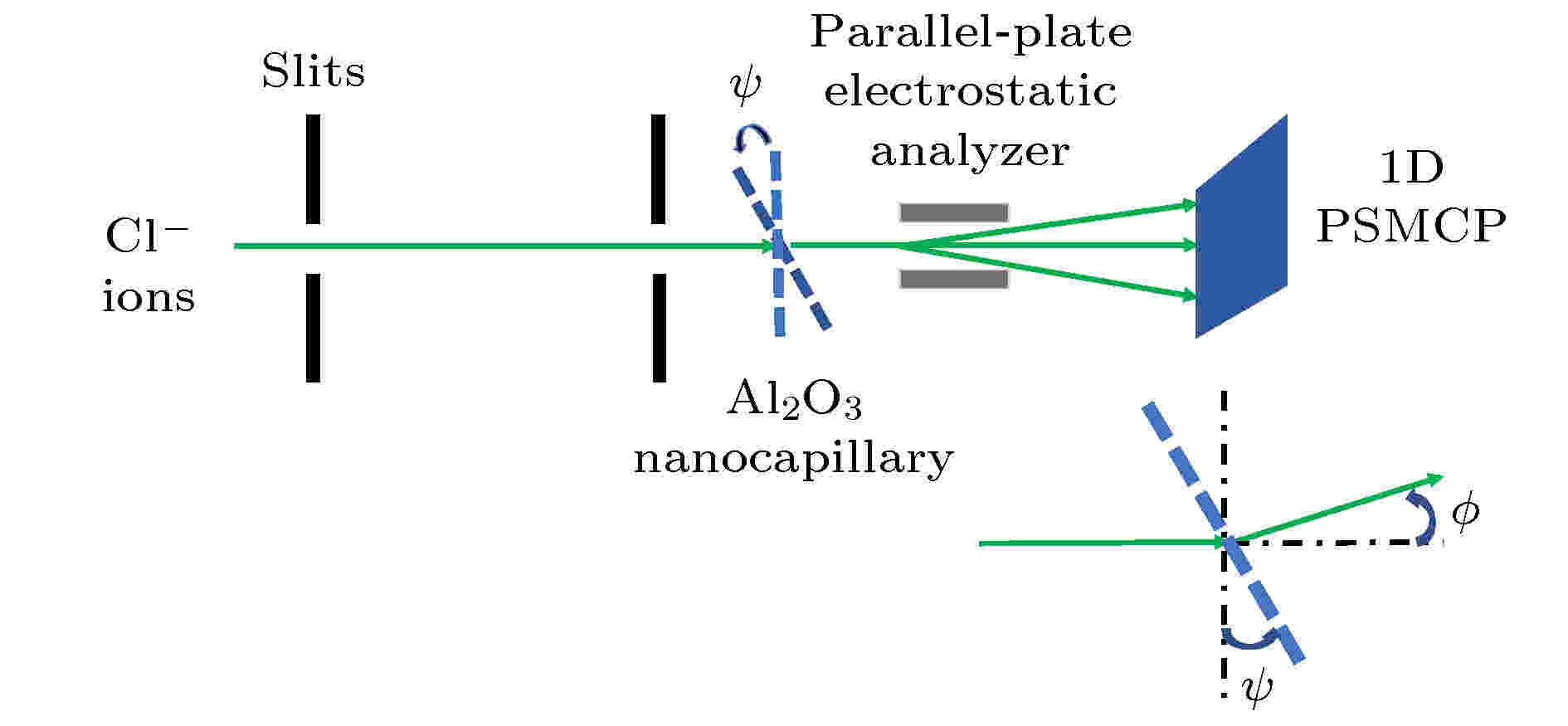
2020, 69 (9): 094101.
doi:10.7498/aps.69.20190933
Abstract +
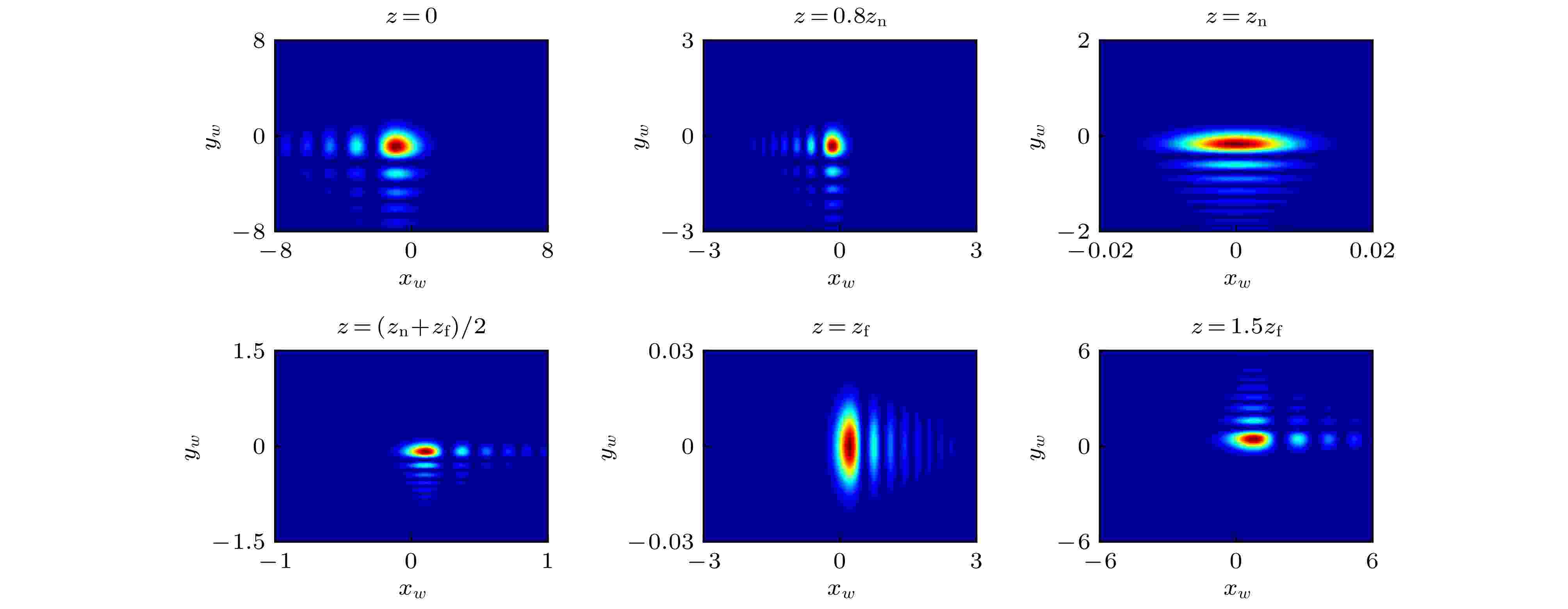
2020, 69 (9): 094102.
doi:10.7498/aps.69.20191592
Abstract +
Airy beams have received considerable attention due to their unique features on propagation, including non-spreading, self-healing, self-accelerating, and parabolic trajectories. Here in this work we study the propagation of linearly polarized Airy beams with an added spherical phase in uniaxial crystal orthogonal to the optical axis. Based on the beam transmission theory in uniaxial crystals, the analytical expressions for the intensity distribution of the beams in different view planes are derived. Numerical calculations are performed and some novel propagation features are presented graphically. It is shown that the Airy beam with an added spherical phase remains linearly polarized but cannot keep other properties unchanged during propagation in uniaxial crystal. Such a beam maintains its intensity profile in the near-field, then with the propagation distance increasing, converts into the Gaussian-Airy beams with different orientations at two specified distances which are codetermined by the extraordinary and ordinary refractive index of the crystal (namelyneandno) and the radius of the spherical phase, and most impressively, forms a mirror-like reflection profile in the far field, i.e., the intensity pattern in the far field returns to the initial Airy beam profile while its orientation on the transversal plane is reversed along the bisector line of the second and fourth quadrant. Note that the intensity pattern successively experiences two mirror transformations along thexandycoordinate axis when passing through these two critical positions, which can give rise to the mirror reflection effect for the whole Airy beam. Moreover, we further demonstrate that the sequences of these two mirror transformations are in close relation with the relative size betweenneandno. Therefore, the results obtained in this paper reveal new propagation features in anisotropic medium of Airy beams with added spherical phase and provide a novel route to controlling propagation properties like the pattern profile and orientation of the Airy beams through choosing appropriate anisotropic materials and the radius of the spherical phase factor. Considering that it is easy to obtain an Airy beam with an added spherical phase which can be realized with an Airy beam through an ideal lens, our investigation may lead to potential applications in many fields where the ability to change profile and orientation of the intensity pattern and the ability to determine the refractive index of anisotropic medium are both required.
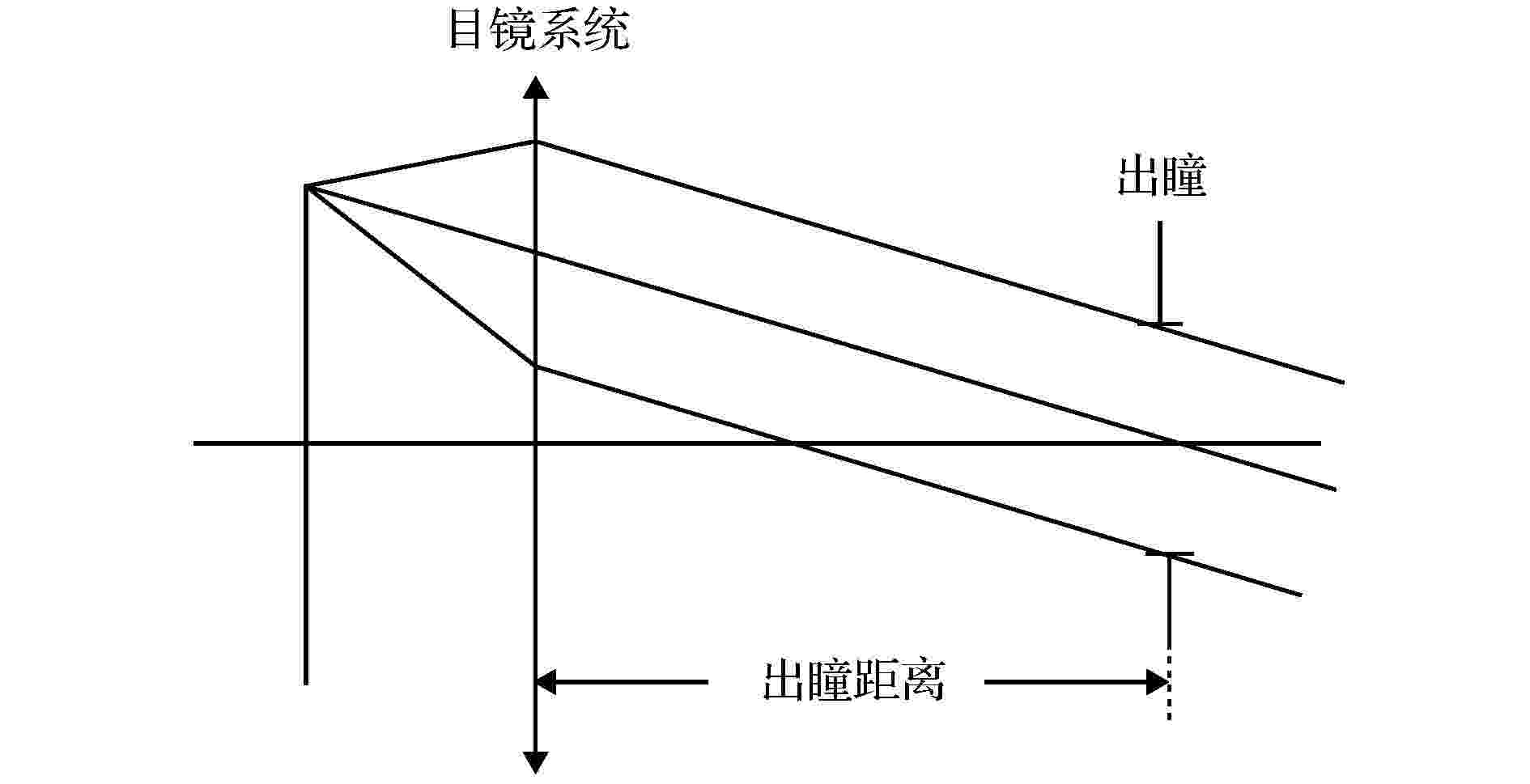
2020, 69 (9): 094201.
doi:10.7498/aps.69.20191828
Abstract +
With the great improvement of microscope property, the eyepiece of microscope is required to have a larger field of view, high magnification, and better imaging quality. Because of the external aperture stop and short focal length, the design difficulty of microscope eyepiece lies in how to correct the distortion and other off-axis aberrations caused by the large field of view, and how to obtain an eye relief that meets the requirements for human observation is also important. The main aberrations of the eyepiece optical system, especially the effect of the optical system with distortion on imaging is analyzed in this paper. The freeform surface is applied to the distortion correction of the optical system of the microscope eyepiece. A wide-angle microscope eyepiece with field of vision of 60° and a magnification of 25× is described in this paper. The full-field distortion is less than 5%. The microscope eyepiece adopts a five-piece three-element structure, in which the freeform surface lens is made of plastic material and is symmetrical about theXOZplane andYOZplane. A high-performance microscope eyepiece design with simple structure, easy processing, and low cost is realized.
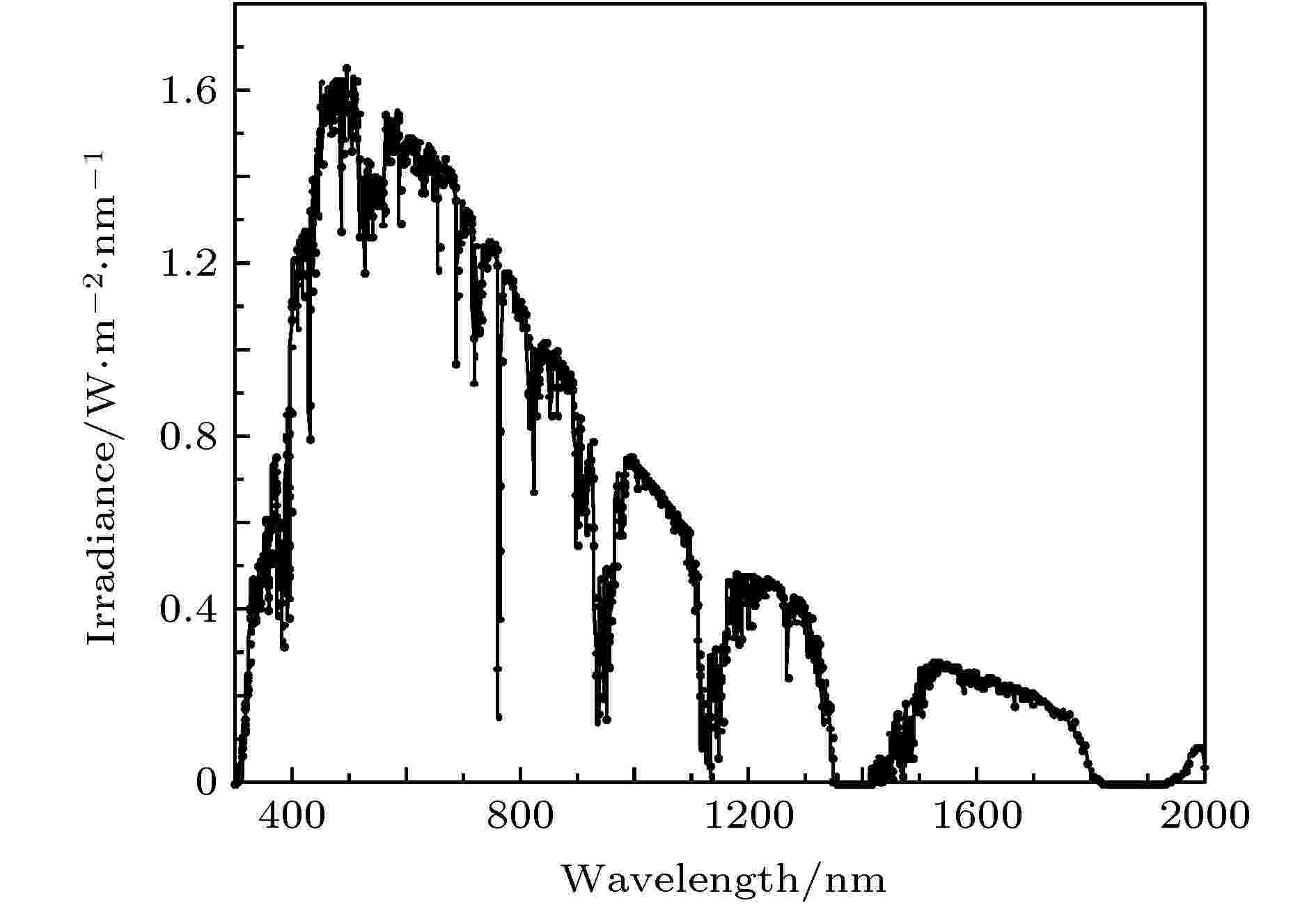
2020, 69 (9): 094202.
doi:10.7498/aps.69.20191985
Abstract +
Solar energy has become one of the new types of energy sources for humanity in the future due to its abundant recourse, clean use and huge reserve. Solar-pumped laser has potential applications in free space optical communications, remote sensing and other fields. However, the research on solar-pumped laser is limited to 1 μm band with neodymium-doped material as a gain medium. To expand the output wavelength range of solar-pumped solid-state lasers, thereby expanding their application fields is one of the goals pursued by researchers in the field. According to the analysis of the absorption spectra of existing solid laser materials, we find that the thulium-doped crystals also have strong absorption peaks in visible light band where solar radiation is strong. Therefore, it is possible that solar-pumped laser could also generate output at 2 μm eye-safe wavelength. In this paper, the absorption spectrum and spectral matching of two common laser crystals—Tm:YAG and Tm:YAP with solar spectrum are analysed and calculated. According to the quasi-three-level transition rate equation of thulium ion and the model of solar-pumped laser system, we obtain the theoretical threshold pump power densities of these two crystals to be 1.14 kW/cm3and 1.434 kW/cm3, respectively. We choose the Tm:YAG crystal with lower threshold pump power density as the gain medium and built a two-stage pumping model with TracePro software. In our model, Fresnel lens is the primary solar light concentrator, and a conical cavity with diffusion reflection surface is used as a secondary concentrator to couple the solar energy to laser crystal. Laser setup parameters such as the distance between the Fresnel lens and the window of conic cavity, length of crystal, taper of conic cavity are optimized with the model. The work in this paper offers a valuable reference for future experimental research of 2 μm solar-pumped laser. Finally, we point out the challenge of the future work. Special attention needs to be paid to the huge thermal effect caused by a large amount of sunlight shining on the Tm:YAG crystal. We could find a new kind of diffuse reflection coolants or use thermally bonded crystals to mitigate thermal effects. It will be the focus of future work.
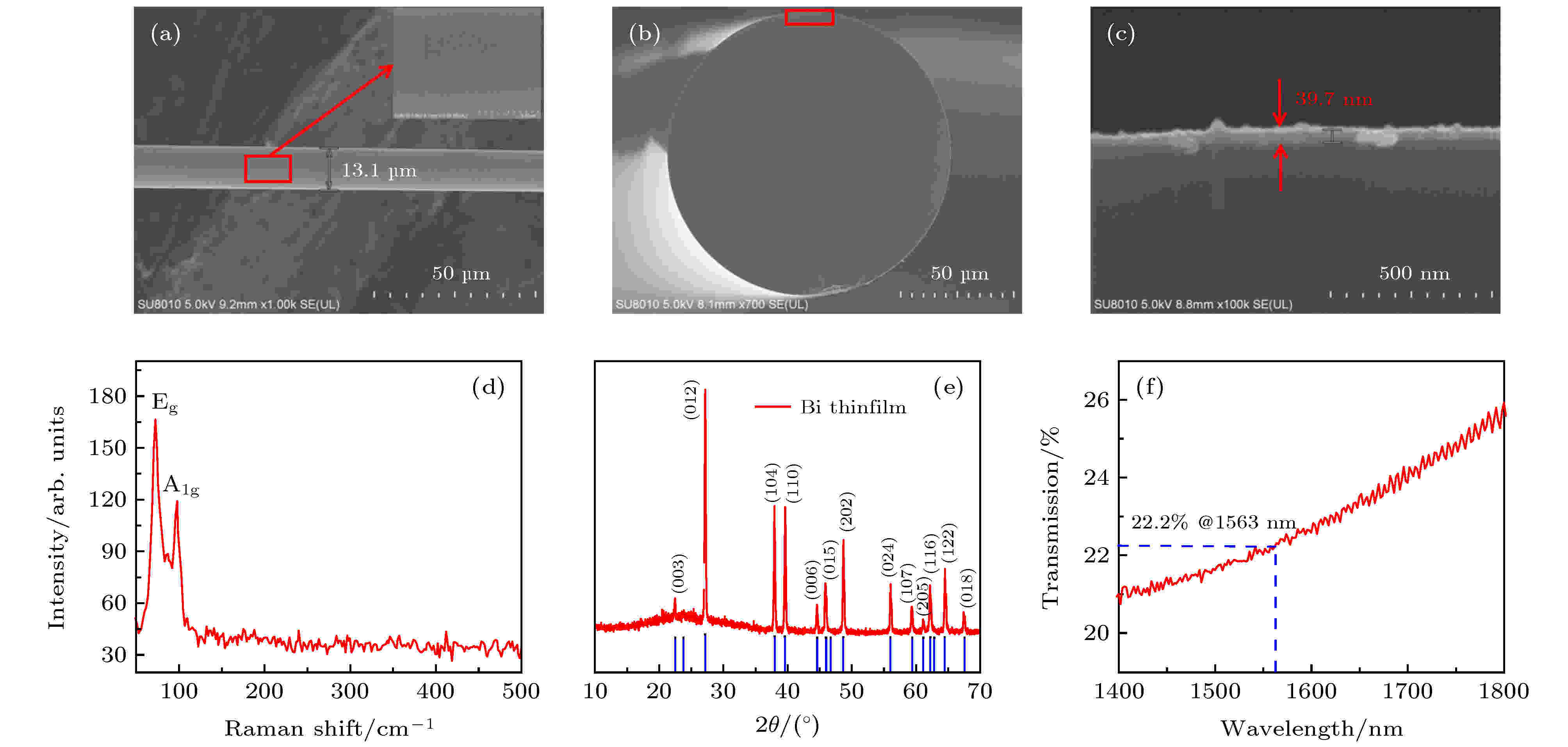
EDITOR'S SUGGESTION
2020, 69 (9): 094203.
doi:10.7498/aps.69.20191995
Abstract +
We demonstrate a bismuth (Bi) saturable absorber (SA) for generating ultrafast pulse. The Bi SA is fabricated by the Bi film deposited on the surface of microfibers through using magnetron sputtering. Its nonlinear optical properties are investigated. The as-prepared Bi SA has outstanding nonlinear absorption property demonstrated by the open aperture (OA)Z-scan system at 1500 nm and balanced twin-detector method at 1560 nm. The nonlinear optical property of Bi SA shows that the modulation depth, the nonsaturable losses, and the saturable intensity at 1.5 μm are 14% and 79%, and 0.9 MW/cm2, respectively. Besides, the closed aperture (CA)Z-scan measurement is also implemented to estimate the nonlinear refractive index of Bi film. The Bi film shows that the typical CA/OA curve possesses the feature of peak-valley profile, meaning that the sample with a negative nonlinear refractive index is self-defocusing. In our experiments, the parameters of the nonlinear absorption coefficientβand the nonlinear refractive indexn2are estimated at about 2.38 × 10–4cm/W and –1.47 × 10–9cm2/W according to the actual experimental data points, respectively. To further investigate its nonlinear optical property, the microfiber-based Bi SA is embedded into an erbium-doped fiber laser with a typical ring cavity structure. Based on the Bi SA device, the stable ultrafast pulses are generated at 1.5 μm with the pulse width of 357 fs, the output power of 45.4 mW, corresponding to the pulse energy of 2.39 nJ, and the signal-to-noise ratio is 84 dB. The stable soliton pulses emitting at 1563 nm are obtained with a 3-dB and 6-nm spectral bandwidth. The experimental results suggest that the microfiber-based Bi SA prepared by magnetron sputtering deposition (MSD) technique can be used as an excellent photonic device for ultrafast pulse generation in the 1.5 μm regime, and the MSD technique opens a promising way to produce high-performance SA with a large modulation depth, low saturable intensity, and high power tolerance, which are conducible to the generation of high power and ultrafast pulse with high stability.
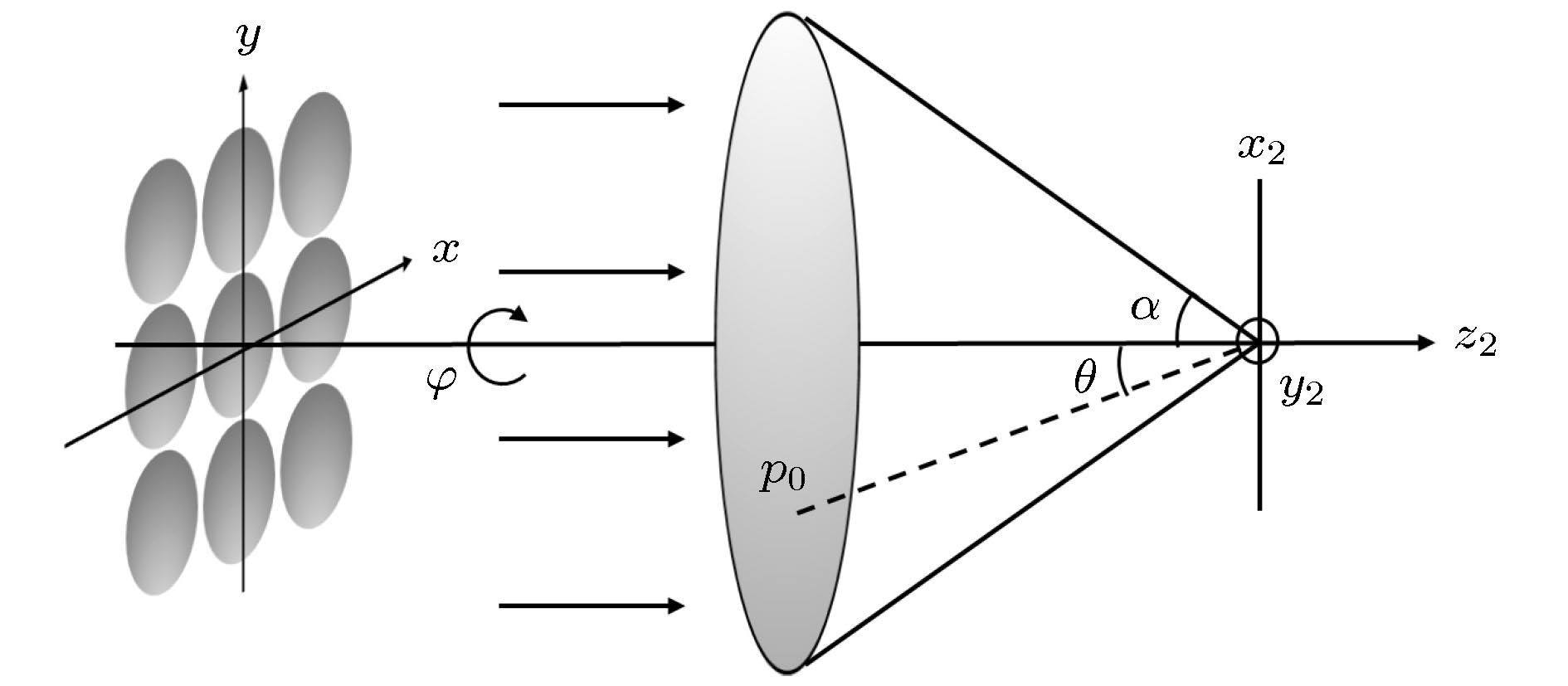
2020, 69 (9): 094204.
doi:10.7498/aps.69.20200034
Abstract +
In order to obtain focal spot with high power and spot size comparable to wavelength scale, a novel approach to achieving the coherent combination of beam array by tightly focusing is proposed. The physical model of coherent beam combination of beam array via tightly focusing is built up by the use of the vector diffraction integral. Therefore the influences of beam configuration, polarization state, beam width, beam interval and numerical aperture of the tight focusing system on the characteristics of the combined beam are discussed in detail. The results indicate that the coherent combination effect of beam array with linear and circular polarization via tight focusing is the first best, and that with the radial polarization is the second best but that with the azimuthal polarization is the worst. The beam array of linear and circular polarization with rectangle configuration can be tightly focused onto center point, and the beam array with hexagon is also focused onto center point but with lower efficiency. In addition, by enlarging the beam width and the beam interval to a certain extent, the combination efficiency can be increased. By optimizing the beam configuration, beam width and interval, and selecting rational numerical aperture of the tightly focusing geometry, the focal spot with high energy concentration can be obtained with high beam quality and combination efficiency.
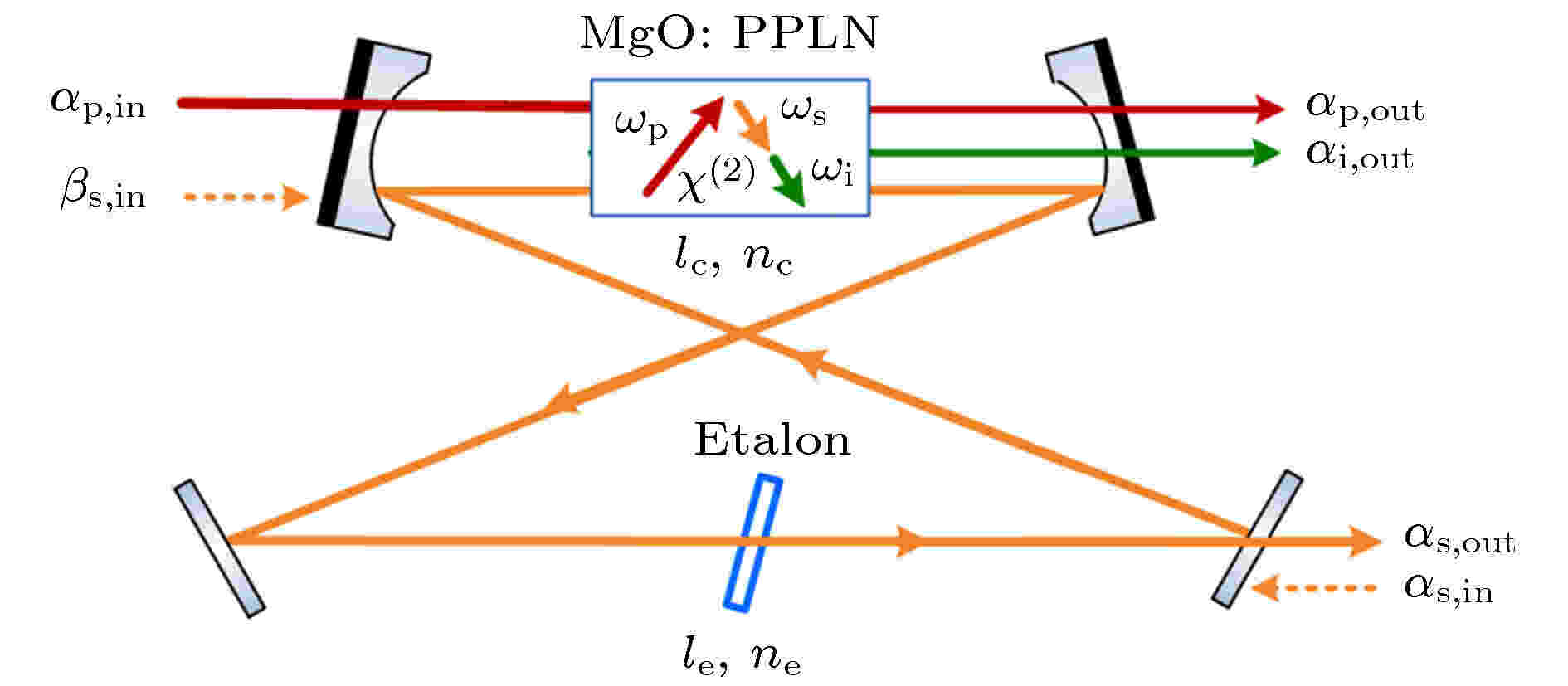
2020, 69 (9): 094205.
doi:10.7498/aps.69.20191952
Abstract +
The infrared laser sources have important applications in many fields such as real-time detection, gas sensing or tracing, high-resolution spectral analysis and quantum optics. In this paper, we develop an infrared laser source with mode-hop-free broadband tunability by using a singly optical parametric oscillator (SRO) based on the magnesium-oxide doped periodically poled lithium niobite (MgO:PPLN) crystal. A polished lithium niobite crystal with a thickness of 1 mm is used as an etalon that is inserted into the cavity of SRO to realize continuous mode-hop-free tuning. The resonant signal in SRO is frequency stabilized to the transmission peak of intracavity etalon. Owing to the high stability of the resonator, continuous mode-hop-free tuning with a bandwidth of 2063.7 GHz for both signal and idler is realized. The oscillation threshold of SRO is 7.3 W. The signal of 4.3 W over 1551.9-1568.6 nm and idler of 2.1 W over 3307.3-3384.3 nm are generated for 22 W of pump power by tuning the temperature of the crystal from 20 ℃ to 70 ℃. The slope efficiency of 42.6% and optical conversion efficiency of 29% are obtained. Then the intensity noise characteristics of generated infrared laser are further studied theoretically and experimentally. The fluctuation characteristics of the SRO emission can be computed just by using a semiclassical approach. We analyze theoretically the factors that affect the intensity noise of the signal and idler. The temperature of the MgO:PPLN crystal and the modulation frequency of the etalon are important parameters, which can affect the intensity noise characteristics of signal and idler laser. Therefore, we investigate experimentally the variation of the intensity noise characteristics by changing the temperature of the crystal and the modulation frequency of the etalon. The intensity noise of the signal and idler laser are optimized through controlling the temperature in a range of 20-60 ℃ and the modulation frequency ranging from 2 kHz to 8 kHz, respectively. The experimental data basically accord with the theoretical calculations. When the operating temperature of the MgO:PPLN crystal is controlled at 60 ℃ and the modulation frequency of the etalon is 8 kHz, the intensity noise of the signal and the idler laser are reduced by 11 dB and 8 dB, respectively. The optimized infrared laser can provide a high-quality laser source for subsequent quantum optics research.
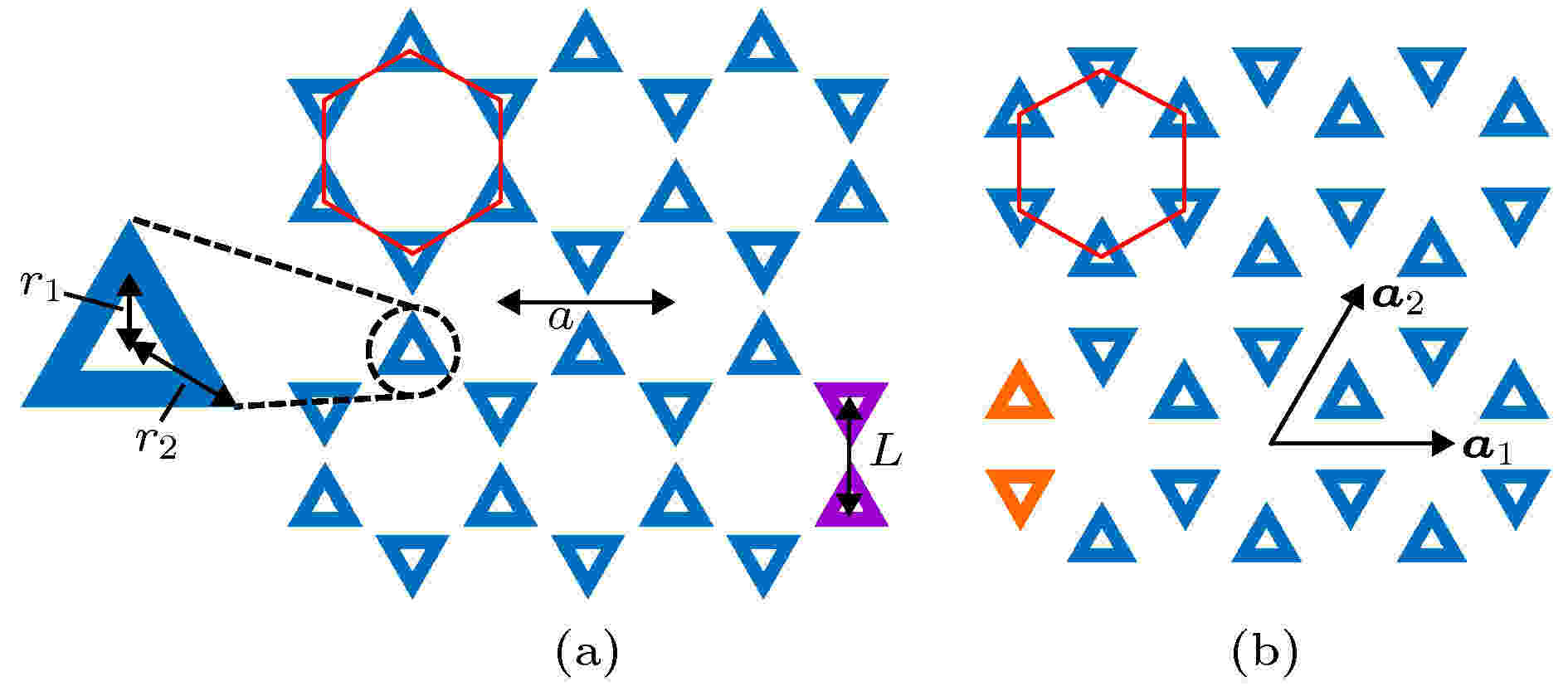
EDITOR'S SUGGESTION
2020, 69 (9): 094206.
doi:10.7498/aps.69.20191962
Abstract +
Based on the transmission properties of against backscattering and robustness against defects, photonic topological insulators have opened up a novel way to steer the propagation of electromagnetic wave. In order to construct the photonic analogs of the quantum spin Hall effect in an electronic system, we propose a simple two-dimensional photonic crystal made of dielectric materials to realize topologically protected edge states associated with the photonic pseudospin. The photonic crystal comprises a honeycomb array of equilateral-triangle-ring-shaped silicon rods embedded in an air host. By simply rotating the silicon rods around their respective centers by 60°, the band inversion between a twofold degenerated dipolar mode and a twofold degenerated quadrupolar mode is clearly observed in the Brillouin zone center. For the double twofold degenerated states, the chirality of the time-averaged Poynting vector surrounding the unit cell center (i.e., right-hand or left-hand circular polarizations) plays the role of the pseudospin degree of freedom in the present photonic system, and their point group symmetry can be utilized to construct a pseudo-time-reversal symmetry. By utilizing
${{k}} \cdot {{p}}$
perturbation theory, we develop an effective Hamiltonian for the associated dispersion relation around the Brillouin zone center and calculate the spin Chen number, which indicates that the band inversion leads to a topological phase transition from a trivial to a nontrivial state. With numerical simulations, we unambiguously demonstrate that the unidirectional propagation of pseudospin-dependent edge state along the interface between a topologically nontrivial photonic crystal and a trivial one, and robustness of the edge states against different defects including sharp bend and cavity, regardless of the type of interface. The photonic system proposed by us consists of dielectric materials and the corresponding lattice structure is simple. And without changing the fill ratio or changing the positions of the silicon rods, a simple rotation of the silicon rods can generate the topological phase transition. So the potential applications of the pseudospin-dependent edge states based on our design are expected in more efficient way.
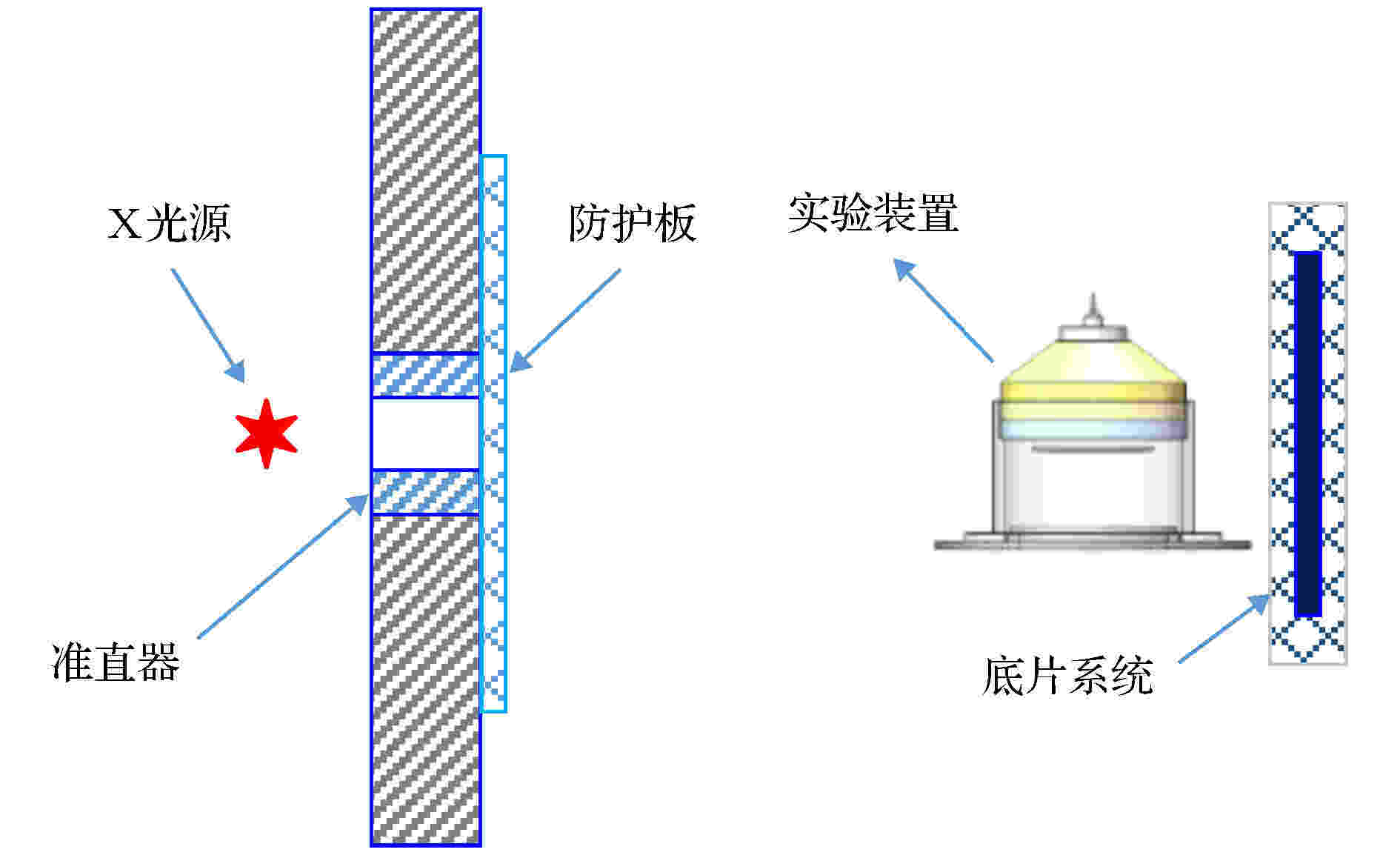
2020, 69 (9): 094701.
doi:10.7498/aps.69.20191999
Abstract +
The instability of metal interface is an important problem in the process of implosion physical compression, which is significantly different from the traditional fluid interface instability. Due to the limitation of related theory and experimental diagnosis technology, this problem is studied still insufficiently. In order to understand in depth the perturbation growth behavior of metal interface instability, the technique for high explosive driven Rayleigh-Taylor instability experiment on the oxygen-free high conductivity (OFHC) copper is developed. The perturbation growth on OFHC copper interface with varying initial perturbation amplitude at a specific time is recorded by radiography. According to the data processing on the X-ray images, the perturbation growth behaviors of the interface at different times are obtained. The experimental results show that the larger the initial perturbation amplitude, the faster the perturbation grows, but the perturbation wavelength of the interface remains almost unchanged at the explosive loading. The perturbation on the front interface will have an effect on the back free interface, and cause some corresponding disturbance to occur on the surface, namely, on the back free interface, the position corresponding to the perturbation trough of the front interface first moves and gradually evolves into a spike, while the position corresponding to perturbation crest evolves into a bubble. The strain rate of instability perturbation growth reaches ~105/s, and the perturbation amplitude of the interface increases to about 700% of the initial value at 5.26 μs. The corresponding numerical simulation results show that the normal SCG model underestimates the strength of copper and cannot well describe the stabilizing effect of material strength at this high strain rate, thereby leading to the fact that the simulation results are higher than the experimental results.
CONDENSED MATTER: STRUCTURAL, MECHANICAL, AND THERMAL PROPERTIES
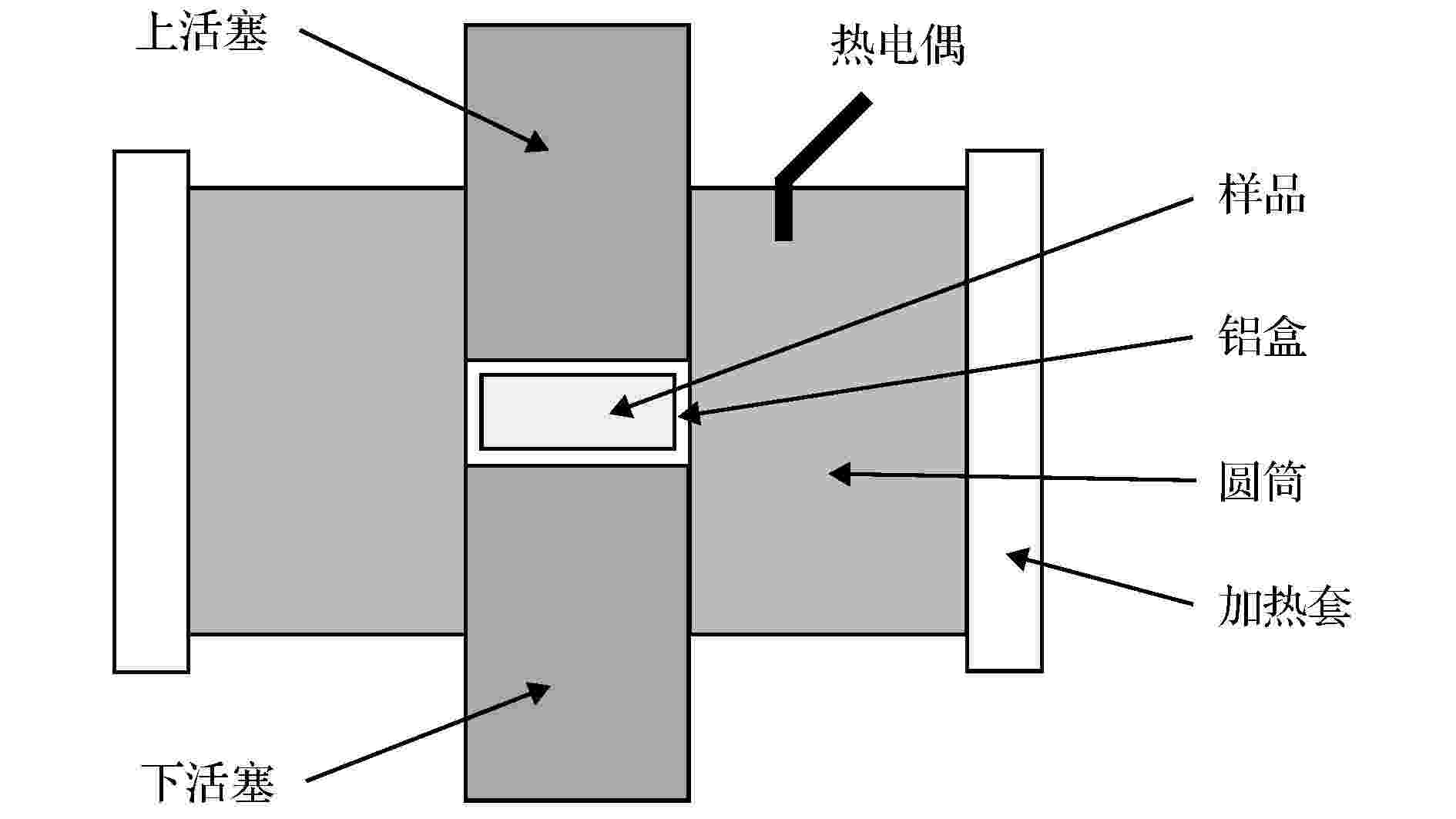
2020, 69 (9): 096101.
doi:10.7498/aps.69.20191820
Abstract +
In this work, pressure-induced rapid solidification of polyphenylene sulfide (PPS) melt is studied on a pressure-jump apparatus. Five PPS samples under a pressure of 0.1 GPa are heated to 563 K, 573 K, 583 K, 603 K and 613 K, respectively. These samples are rapidly compressed to 2.4 GPa in about 20 ms. The solidified samples are quenched to room temperature and then depressured to ambient pressure. The X-ray diffraction (XRD) analyses of the recovered samples indicate that three PPS samples, prepared at 563 K, 573 K and 583 K, contain crystal phases but their crystallinity is lower than that of the original PPS powder. The remaining two PPS samples, prepared at 603 K and 613 K, are in amorphous state but do not sharp crystal diffraction peaks in the XRD patterns. Differential scanning calorimetry curves of the five PPS samples each display an endothermic step of glass transition at about 325 K and an exothermic peak of recrystallization around 360 K. The glass transition temperature decreases roughly with the increase of preparation temperature. The thermal enthalpy of recrystallization process increases with the increase of preparation temperature, indicating that the content of amorphous phase increases. We speculate that the recovered samples are in a “frozen state” of their parent liquid. At 563 K, 573 K and 583 K, the crystalline phases partially melt. More crystal phases melt with the increase of preparation temperature. The molten part is rapidly solidified into amorphous phase. At a temperature higher than 603 K, the crystalline phase fully melts, and after being rapidly compressed, amorphous PPS sample is obtained. For the amorphous PPS sample prepared at 613 K, we investigate whether the interior of this amorphous PPS sample is also in amorphous state. Micro XRD analysis indicates that the central part of the PPS sample is also in amorphous state, which suggests that this PPS sample is of a fully amorphous bulk. For the amorphous PPS sample prepared at 613 K, we investigate its recrystallization product. After being annealed at 425 K for 2 h, the amorphous phase, which is solidified from the melt of crystal phase, is recrystallized into the orthorhombic crystal phase. The results in this work indicate that the rapid compression can inhibit the PPS melt from being crystalized, so, it is a way to prepare amorphous PPS bulk. Since the solidification of polymer melt is realized by increasing pressure instead of quenching and is not limited by polymer thermal conductivity, it is a promising way to prepare amorphous polymer bulks with large size.

2020, 69 (9): 096102.
doi:10.7498/aps.69.20200112
Abstract +
Kirigami, the art of cutting paper, recently emerged as a powerful tool to substantially modify, reconfigure and program the properties of material. The development of kirigami technology provides an effective solution for designing the inorganic flexible electronic devices. Pyramid kirigami, as a kind of kirigami structure, shows a large vertical extension characteristic. It has been widely used to demonstrate versatile applications, such as graphene kirigami spiral spring, three-dimensional stretchable supercapacitor, and wearable flexible sensors. In the present work, we construct a polygonal radial symmetric pyramid kirigami by introducing some cuts in the elastic sheet. The mechanical behavior of pyramid kirigami is investigated based on the cantilever formula solved by Galerkin method. In addition, a “beam model” is proposed to explain deformation process of pyramid kirigami, which consists of several “beam elements” containing two cantilever beams. The formula for the relationship between the elastic coefficientKand the structural parameters of the regularN-sided pyramid kirigami ofnmodules is obtained by combining several cantilever beams. The formula for the linear threshold of deformationDTis obtained based on the comparison between the approximate curve of small deflection and the theoretical curve of a cantilever beam. When the deformation of the structure exceeds the linear threshold, the structure cannot keep the elastic coefficientKvalue linear any more, and the mechanical behaviors become non-linear. The simple geometric relationship of a single module is used to explain the out-of-sheet distortion of the structure. The proposed theoretical model is confirmed by finite element method simulation and experimental methods, and it is used to analyze the mechanical characteristics of graphene krigami reported. The results indicate that the defined parameters can be adjusted to tailor or manipulate the ductility and mechanical behaviors. This work provides theoretical support for the application of pyramid kirigami in the field of flexible devices. In the macroscopic field, the pyramid kirigami structure is expected to be applied to the field of flexible devices as a flexible structure with controllable elastic coefficient. In the microscopic field, it is expected to use two-dimensional materials to make force measurement devices with a simple visual readout and femtonewton force resolution.
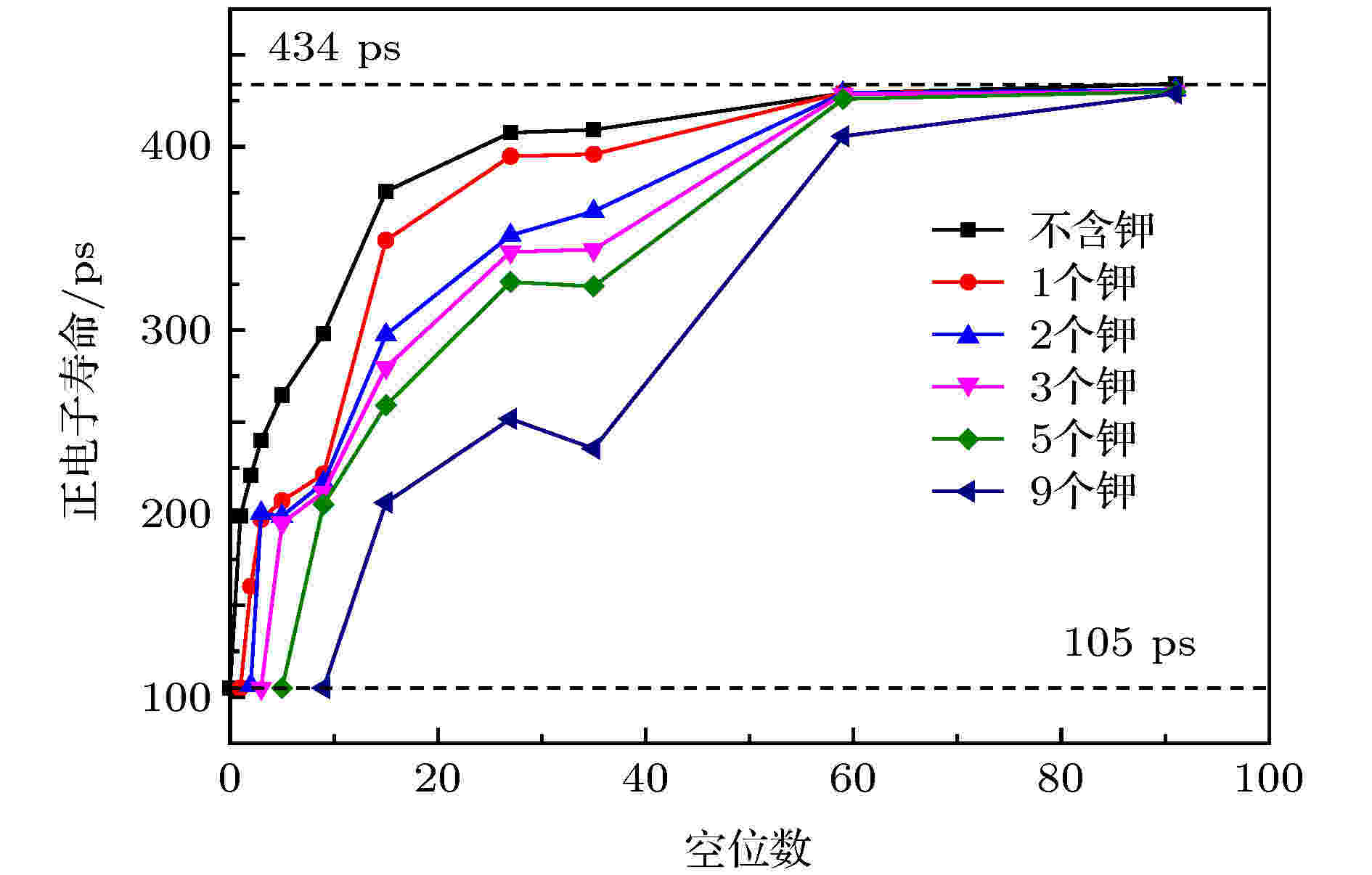
2020, 69 (9): 096103.
doi:10.7498/aps.69.20191792
Abstract +
Tungsten alloy is known as a promising plasma-facing material (PFM) in IETR because of high strength, high-temperature stability, low sputtering erosion, low tritium retention, etc. However, tungsten has some disadvantages, such as high ductile-brittle transition temperature, low temperature brittleness, and radiation embrittlement. For the severe environment of PFM, various techniques have been adopted to improve W-based materials, among which the potassium doping is an effective bubble strengthening method, it can bring in nano-sized K bubbles, and enhance the toughness and strength, thermal shock performance, irradiation resistance of the materials. The K bubbles, which can pin grain boundaries (GBs) and dislocations, are the most characteristic defects in W-K alloy and have been widely reported. However, little attention is paid to other defects such as vacancies, GBs and dislocations. In fact, high-density dislocations exist in W-K alloy and vacancies play a considerable role in forming the K bubbles. Thus, positron annihilation technique (including the positron annihilation lifetime spectrum and slow positron beam Doppler broadening spectrum), which is a useful technique for detecting defects in solids, can be used to study these defects in W-K alloy samples. The positron lifetime of potassium bulk is about 376 ps and the positron lifetime of tungsten bulk is about 110 ps. But by simulating positron lifetime of defects in tungsten, it is found that potassium atoms in tungsten lattice do not exhibit the characteristic positron lifetime. Therefore, potassium is not considered in analyzing positron annihilation lifetime spectra of W-K alloy samples with different potassium content (46, 82, 122, 144 ppm). Three-state capture model is established in this paper, the dislocation density and vacancy cluster concentration of these samples are obtained. From the results, the dislocation densities in all samples are very high, but vacancy cluster concentrations are relatively low, and the vacancy cluster concentration in the sample with 82 ppm potassium content is the lowest in all samples. The behavior of potassium atoms in the sintering process is also discussed. Then the slow positron beam Doppler broadening spectra of W-K alloy samples and pure tungsten samples are measured and the obtained data are fitted by VEPFIT. It is noted that the defects in W-K alloy samples are much more than those in pure tungsten sample, and are distributed homogeneously with depth. The positron diffusion length information simultaneously obtained is compared with these values computed by dislocation density and vacancy cluster concentration, confirming the positrons trapped by potassium bubbles and grain boundaries are existent.
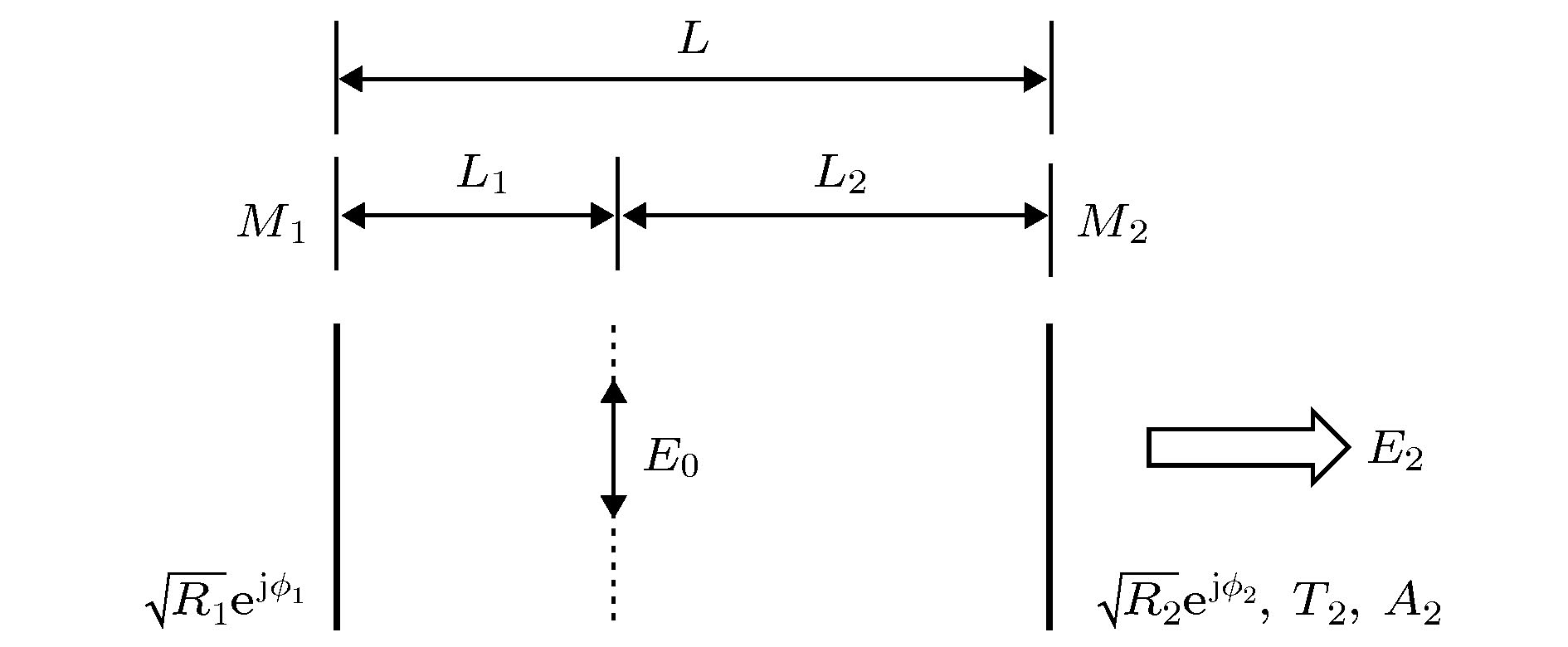
2020, 69 (9): 096104.
doi:10.7498/aps.69.20191576
Abstract +
Comparing with traditional single organic light-emitting device (OLED), the luminance efficiency and lifetime of tandem OLED are significantly improved. Therefore, it is of crucial importance to in depth study the influence of microcavity effect on the performance of top emitting tandem OLED. In this paper, taking the blue organic light emitting device for example, the change rule of optical and electrical properties of top-emitting tandem blue-light device are studied by combining optical simulation with practical experiments. The specific experiment is as follows. The top emitting tandem blue organic light devices are fabricated, in which the two light-emitting layers are located at the first anti node and second anti node, the second anti node and third anti node, and the third anti node and fourth anti node in the optical structure of the device respectively. It is found that the performance of the device is better when the two emitting layers of the top-emitting tandem blue light device are located at the second anti node and third anti node in the optical structure of the device respectively. That is to say, when the current density of the device is 15 mA/cm2, the current efficiency of the device reaches 10.68 cd/A, color coordinate (CIEx,y) of the device is (0.14, 0.05), and the time of the brightness decreases from 100% to 95% in 1091.55 hours, which is likely to be due to the fact that when the cavity length of the device is long, it can not only improve the recombination rate of hole and electron in the first light-emitting unit, weaken the surface plasmon polarition effect, reduce the influence of the fluctuation of the film thickness on the cavity length of the device, but also play a role of wrapping partials to a certain extent, improve the efficiency and prolong the device lifetime. The research results provide an important theoretical and data basis for designing the top-emitting tandem blue light device with high efficiency and long lifetime. In the future, we will continue to systematically and detailedly study the top emitting tandem organic light-emitting devices, which will provide strong support for preparing the laminated devices with high efficiency long-lifetime, and lower cost.
CONDENSED MATTER: ELECTRONIC STRUCTURE, ELECTRICAL, MAGNETIC, AND OPTICAL PROPERTIES
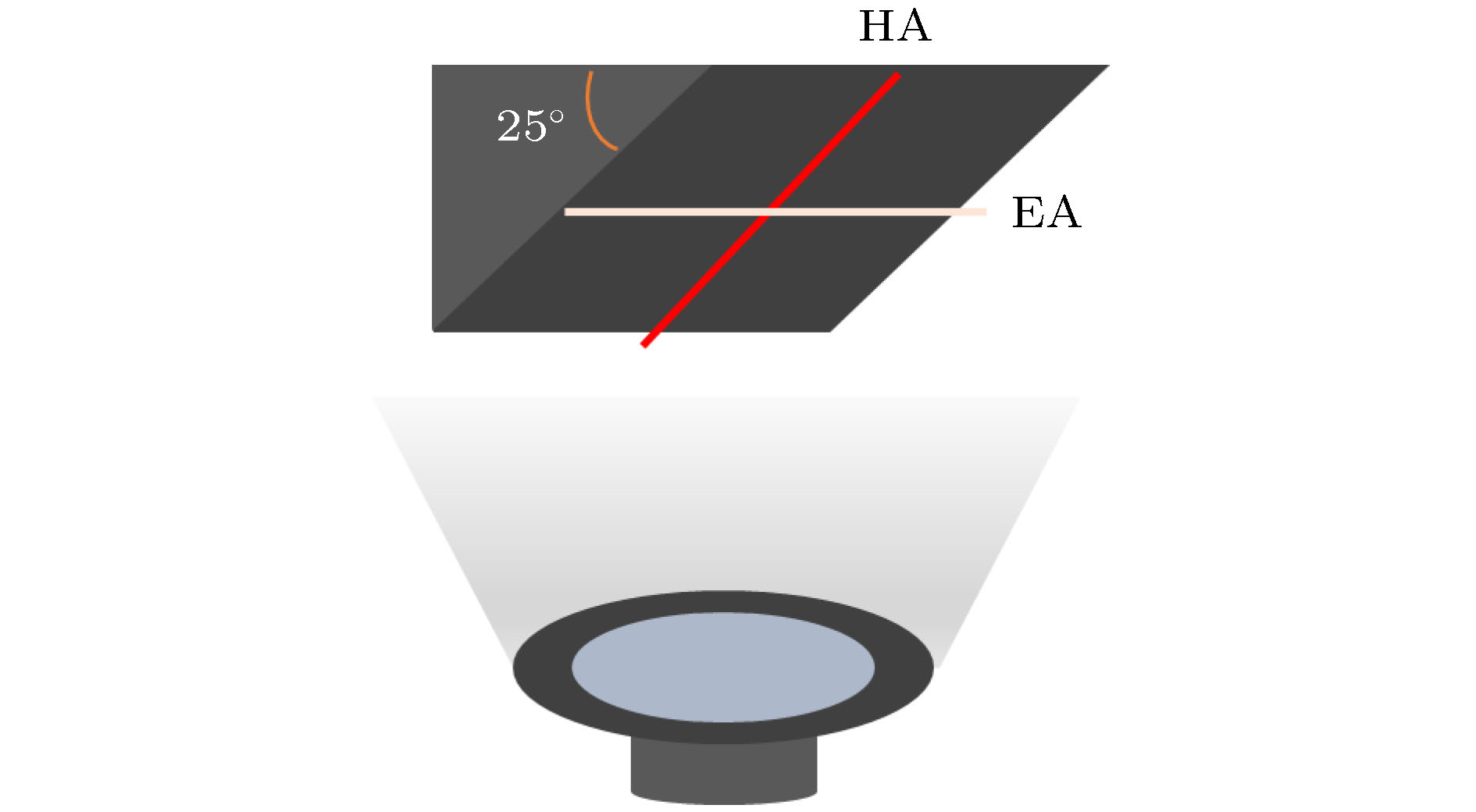
2020, 69 (9): 097401.
doi:10.7498/aps.69.20191942
Abstract +
In this paper, Ni88Cu12thin films are prepared on Si substrates by radio-frequency magnetron co-sputtering. The effects of film thickness and heat treatment on domain structure and magnetic properties are studied. The Ni88Cu12films with thickness less than 210 nm show weak in-plane anisotropy. After the vacuum magnetic field heat treatment, the crystal grains of all films grow, and the in-plane anisotropy extents of Ni88Cu12films with thickness less than 210 nm become weaker. The films have different morphological characteristics at different heat treatment temperatures. The surface of the film is very dense before heat treatment. After heat treatment at 300 °C, it forms island shape due to the solid solution between the grains. Compared with the grains on the surface of the heat-treated film at 300 °C, the grains grow further after being heat-treated at 400 °C. Grown grains cover the gaps between the grains, which makes the film surface flat. The results of in-plane normalized hysteresis loop of the films show that the critical thickness of the stripe domains decreases after heat treatment. The stripe domain structure appears in the 210-nm-thick films without being heat-treated. For the film with the heat treatment, its remanence ratioMr/Msdecreases, and the saturation fieldHsincreases, and thus leading the perpendicular anisotropy constantKpto increase. Therefore, the thickness of the stripe domain in the film after being heat-treated decreases. Compared with the films after being heat-treated, the 105-nm-thick as-prepared Ni88Cu12film has a maximum natural resonance frequency of 2.1 GHz, which is attributed to the uniaxial anisotropy of the as-prepared Ni88Cu12film. The saturation magnetization of the 300 °C-treated 105-nm-thick film decreases to 3.01 × 105A/m. However, the saturation magnetization decreases to 5.9 × 105A/m after heat treatment at 400 °C. Moreover, the ferromagnetic resonance peak of the film narrows after being treated at 300 °C, and the resonance frequency decreases to 1.95 GHz.
INTERDISCIPLINARY PHYSICS AND RELATED AREAS OF SCIENCE AND TECHNOLOGY

2020, 69 (9): 098201.
doi:10.7498/aps.69.20191761
Abstract +
Graphene-based materials have aroused great interest for their potential applications in water desalination and purification membranes attributed to their ultrathin thickness, high mechanical strength, and anti-foiling properties. Reverse osmosis (RO) technology is currently the most progressive, energy-saving and efficient separation technology by membranes, therefore the new materials with high strength, strong pollution resistance and excellent performance are urgently needed. The ability of porous graphene to serve as a kind of novel advanced RO membrane is due to two major potential strengths of this atomically thin two-dimensional material, i.e., ultrahigh permeability and super selectivity. Thus, the reverse osmotic properties of the porous graphene membranes should be further investigated theoretically. In this paper, classical molecular dynamics method is used to investigate the reverse osmosis characteristics of brine in hydrogenated porous graphene reverse osmosis membrane. The results show that the water permeation rate increases with the driving force, pore size and temperature increasing, for the pore diameter larger than the hydration radius. The ion rejection rate decreases with the driving force and temperature increasing. Interestingly, as the porous graphene moves in the tangential direction to perform a shearing process, the interception rate of the salt ions can be effectively improved and the concentration difference polarization phenomenon can be reduced with the tangential velocity increasing, although the water flux decreases slightly. The influence mechanism of each parameter on permeability and on water flux are explored by analyzing the hydrogen bond distribution, the ionic hydration in feed solution, and the energy barrier of the water molecules in penetrating process. In order to further evaluate the effects of various parameter changes on the benefits of reverse osmosis membranes, both the selectivity and permeability are calculated to evaluate the tradeoff between permeability and selectivity, indicating that the increase of the pore diameter can obtain both high permeability and selectivity under the shearing circumstance of the membrane. The research results in this paper will provide a theoretical understanding of porous graphene-based desalination membrane and also may be helpful in designing the shearing graphene-based water filtration devices.
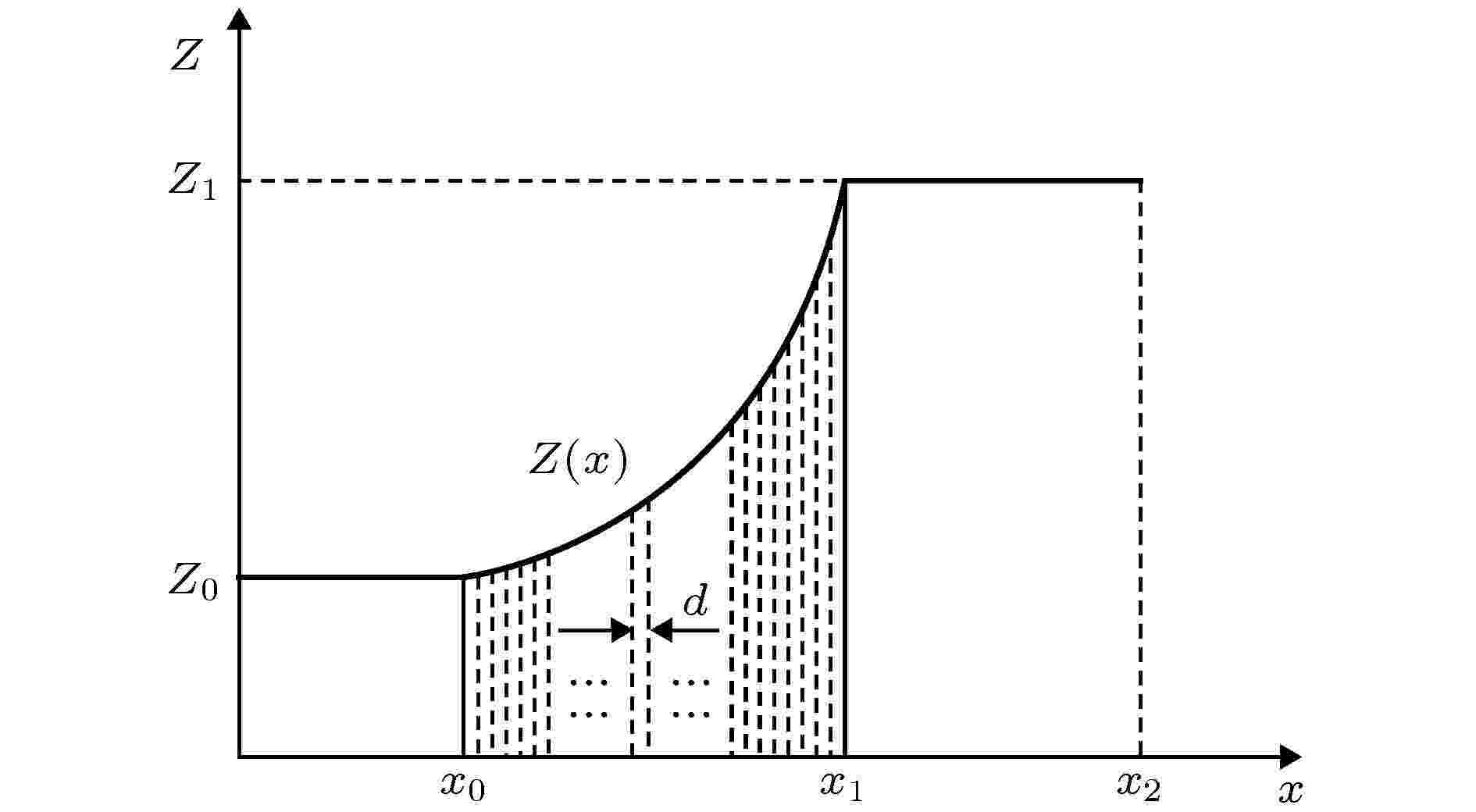
EDITOR'S SUGGESTION
2020, 69 (9): 098301.
doi:10.7498/aps.69.20200326
Abstract +
In this paper, a gradient-like structure composed of magnetorheological (MR) fluids is proposed, and its vibration transfer characteristic is studied through the modeling, numerical calculation and experimental test. Under the action of an externally applied magnetic field, the MR fluid exhibits the liquid-solid transformation property: the process of transformation between solid and liquid in fact is the change of vibration-transfer impedance. Therefore, based on this property, the gradient-like structure is constructed by controlling the external magnetic field. Based on the wave equation of one-dimensional elastic wave propagation, the wave equation of elastic wave transfer in the gradient-like structure is established. In order to describe the relationship between the complex shear modulus and Lame constant of MR fluid and magnetic field intensity in the wave equation, the equivalent parameter model of MR fluid is established based on the theory of elasticity and viscoelastic materials. Then, the experimental set-up is built to modify this model through experiments. Afterward, the discretization method of continuous medium and transfer matrix method are adopted to solve the wave equation, and the expression of vibration level drop is obtained. Through the numerical calculation, the trend of vibration level drop varying with the frequency of incident elastic wave and the intensity of magnetic field for the gradient-like structure is obtained. Finally, the vibration transfer characteristic of the gradient-like structure is studied experimentally, and the influence of magnetic field intensity on the vibration transfer characteristic of the gradient-like structure is analyzed. The results show that the numerical results are in good accordance with the experimental results, thereby verifying that the numerical model is accurate. And the gradient-like structure has a better attenuation effect on the elastic wave than the MR fluid under the action of a uniform magnetic field, and has an excellent tunable property as well.
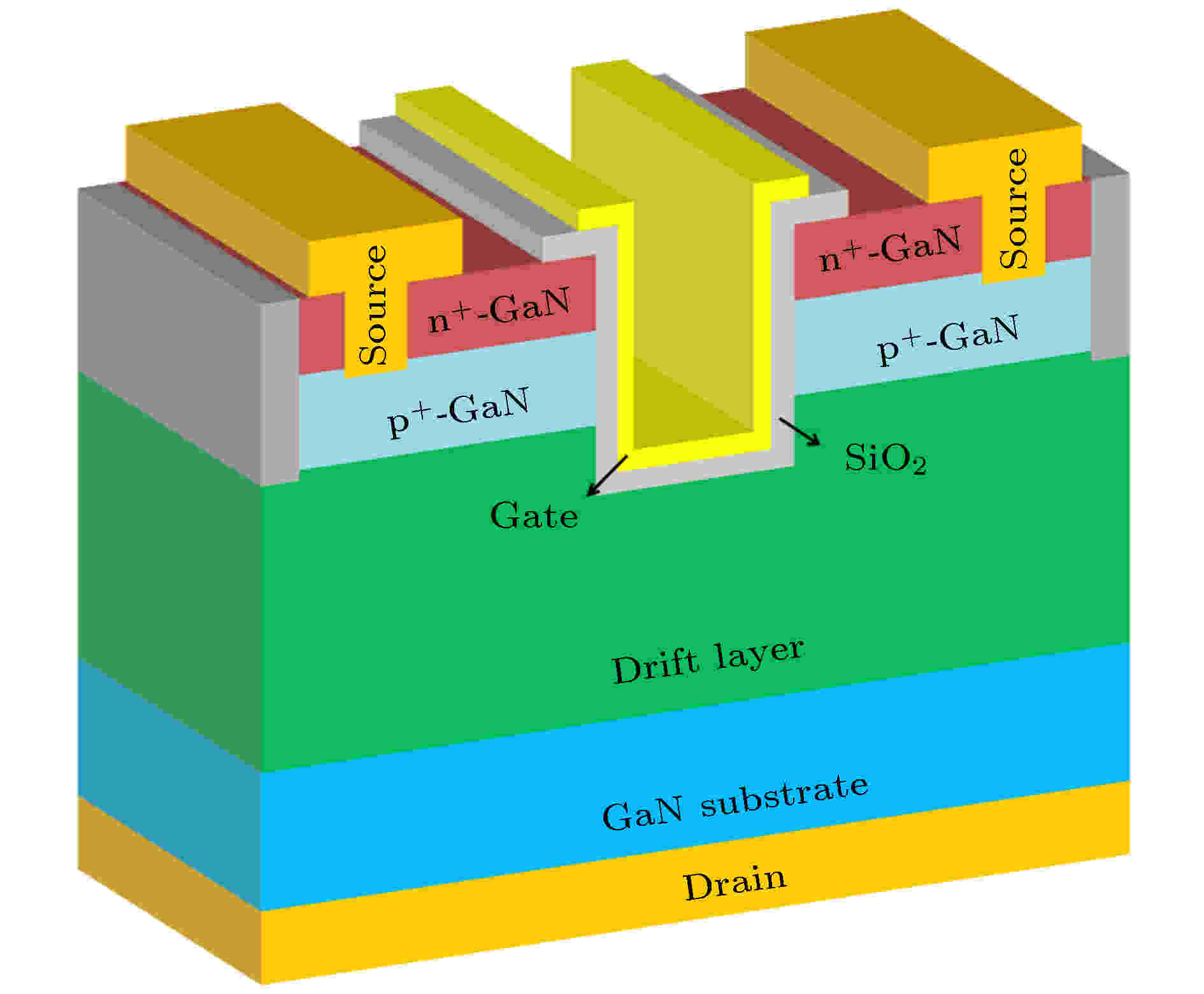
EDITOR'S SUGGESTION
2020, 69 (9): 098501.
doi:10.7498/aps.69.20191850
Abstract +
As reported by several market analysts, GaN-based power devices show great potential applications in the low and medium voltage range ( < 900 V). For high voltage ( > 1200 V), including ship transportation and power grid, the future applications of GaN highly depend on the development of vertical devices based on GaN substrates. Several vertical devices have been reported, such as current aperture vertical electron transistors (CAVETs), U-shape trench metal-oxide-semiconductor field-effect transistors (UMOSFETs), and fin power transistors. And the UMOSFETs show potential advantages due to greater simplicity in material epitaxy and fabrication process. In the fabrication of UMOSFETs, the U-shape trench dry etching is the most critical process. The GaN sidewalls after dry etching directly affect the interface state characteristics in the MOS structure and the channel electron transport. In this work, etching optimization including etching radio-frequency (RF) power and etching mask is investigated and process-dependent electrical characteristics of GaN UMOSFETs are also studied. The appropriate decrease of RF power ensuring the steep sidewalls can effectively improve the channel electron mobility from 35.7 cm2/(V·s) to 48.1 cm2/(V·s) and consequently increase the ON-state current and reduce the ON-state resistance. Larger etching damage to the p-GaN sidewall caused by higher RF power leads the scattering effects to increase and the mobility of the channel carriers to decrease. The interface state density at the channel can be extracted by the subthreshold swing. The interface state density decreases to 1.90 × 1012cm–2·eV–1when the RF power is regulated to 50 W, which is only half of the interface state density when RF power is 135 W. Similar breakdown voltages (350-380 V) are measured for these devices with varying RF power, which are governed by gate early breakdown. Positive valence band offset is formed in the SiO2/GaN MOS structure and the early breakdown occurs due to the holes accumulating at the SiO2/GaN interface. The etching uniformity at the bottom of U-shape trench can be improved by using the SiO2hard masks instead of photoresist masks. Sub-trenches at both ends of the trench bottom are observed in the device with photoresist masks, leading the carrier scattering to increase and ON-state current to decrease. Besides, the interface state density decreases from 3.42 × 1012cm–2·eV–1to 2.46 × 1012cm–2·eV–1with a SiO2hard mask layer used. Compared with 1.6 μm photoresist mask, the thinner SiO2mask with a thickness of 500 nm has a small sidewall area, which weakens the high-energy ion reflection in the inductively coupled plasma system. Consequently, the over-etching at the bottom ends of the trench is improved significantly and therefore the fabricated GaN UMOSFET has higher channel mobility and a lower interface state density.
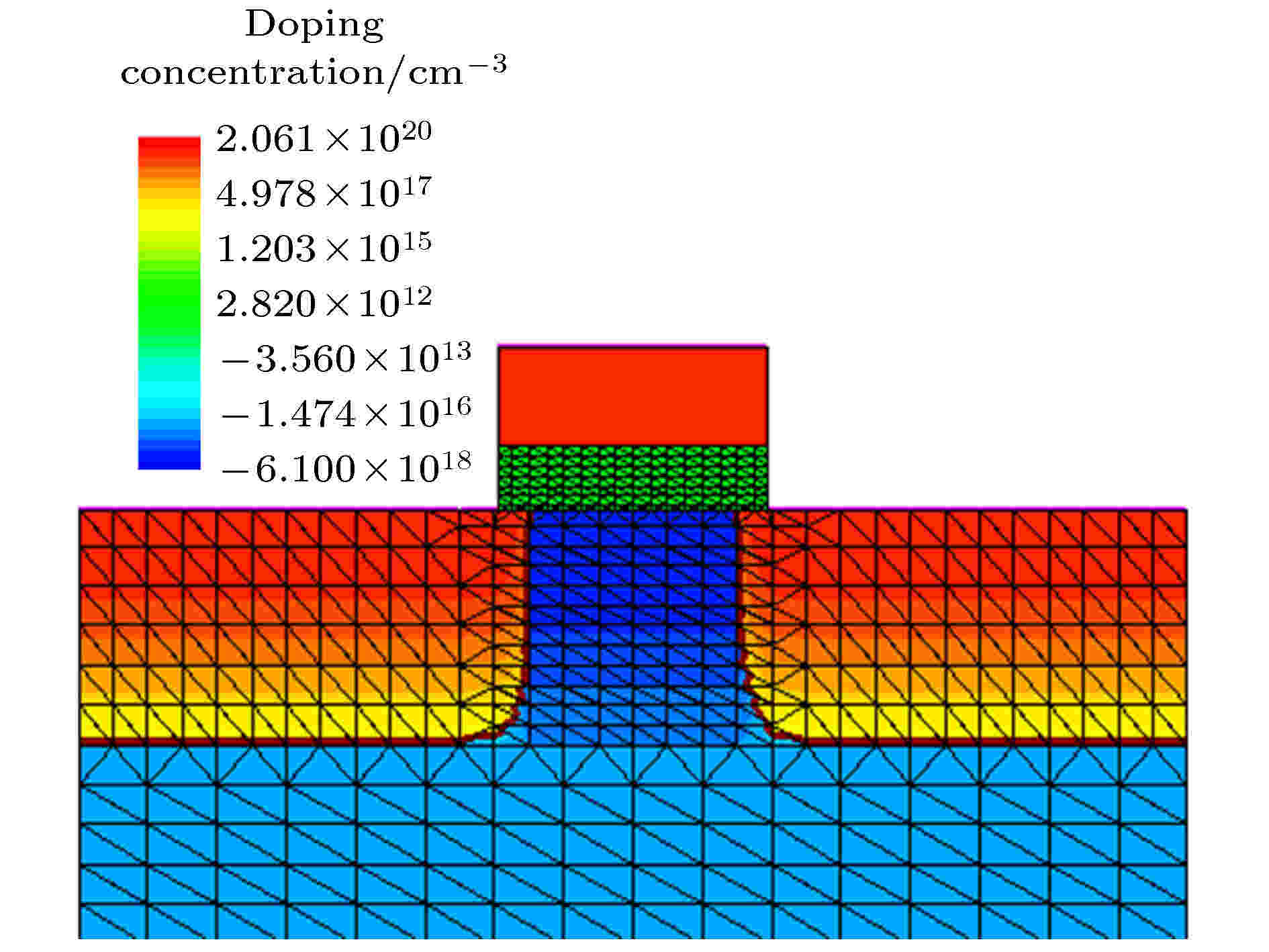
2020, 69 (9): 098502.
doi:10.7498/aps.69.20200123
Abstract +
Ferroelectric field effect transistor (FeFET) is a promising memory cell for space application. The FeFET can achieve non-destructive reading, and has the advantages of simple structure and high integration. Ferroelectric thin film’s size effect, retention performance and radiation resistance of ferroelectric thin films directly determine the performances of FeFET devices. The HfO2is widely used as a dielectric in complementary metal oxide semiconductor (CMOS) device and can solve the common integration problems for ferroelectric materials due to its CMOS compatibility. When the HfO2-based FeFETs are applied to aerospace electronics, the effects of various radiation particles need to be considered. The HfO2-based FeFET memory is still in the experimental stage, and there are no products of HfO2-based FeFET chips available from the market, so it is difficult to carry out experimental research on its single particle effect In the case of lacking the finished products of HfO2-based FeFET devices, using the device-hybrid simulation method to study the HfO2-based FeFET single-particle effect is a necessary and feasible content for the research on HfO2-based FeFET single-particle effects. In this paper, the device-circuit simulation method is used to build a read-write circuit of HfO2-based ferroelectric field-effect transistor. The change of read and write data after a single particle is incident on a ferroelectric field effect transistor memory cell and a sensitive node of a peripheral sense amplifier is studied, and the internal mechanism of read and write data fluctuation is analyzed. The results show that when high-energy particles enter into the drain of the ferroelectric memory cell in the read-write circuit, the memory cells in the “0” state generate electron-hole pairs, which accumulate inside the device, causing the gate electric field strength and ferroelectricity to increase, and the memory cell in the “1” state has a large fluctuation in the output transient pulse voltage signal due to the charge injection of the source, indicating that the ferroelectric memory cell has a good performance against particle flipping; when high-energy particles enter into the amplifier’s sensitive node, a collection current is generated, causing the amplifier in the state of reading “0” to turn on, and the output data to fluctuate. Owing to the fluctuation time being only 0.4 ns, the data does not have single-particle flipping energy under normal readout, and the HfO2-based FeFET read-write circuit has excellent resistance to single particles. When two beams of high-energy particles act on the drain of a ferroelectric memory cell successively in a time interval of 0.5 ns, the output data signal fluctuates more than in the case of a single beam of high-energy particles, and the final output voltage difference in the reading and writing “1” state becomes smaller.

2020, 69 (9): 098801.
doi:10.7498/aps.69.20191697
Abstract +
Patterned electrodes are widely used in the development of novel electrodes of solid oxide fuel cells (SOFCs) because of their well-controlled geometries, distinguishable catalytically active sites and simple transport paths. In the existing studies the patterned electrodes are usually adopted to reveal relevant reaction mechanisms and to investigate the electrochemical characteristics of new materials of SOFCs, however, the effects of electrode geometry are not taken into consideration. In the present paper, a lattice Boltzmann model for simulating the charge transport and electrochemical reaction in an SOFC patterned anode is established, and the key dimensionless parameters governing the above electrode process are deduced. This model is then used to investigate the effects of the key dimensionless parameters on the electrochemical performance of a patterned anode. More importantly, the influences of the patterned anode geometry on the coupling of the charge transport and electrochemical reaction are unraveled. According to the sensitivity of the electrode performance to the dimensionless parameters, a dimensionless phase map, which is divided into maximum area, transition area and minimum area, is built. It is concluded that the transition area, in which the electrode performance varies dramatically with the parameters of design and operation, is regarded as the optimal range for studying the relevant reaction mechanism. Meanwhile, it is found that although the electron transport does not restrict the electrode performance, the moderate decrease of the height-to-width ratio of electronic conductor is capable of enlarging the transition area, which is beneficial to revealing the relevant reaction mechanism. Conversely, the ion transport is the rate-limiting step, however, the transition area remains unchanged under different ionic conductor geometries. The present numerical method and conclusions could offer guidance for rationally designing and operating the patterned electrodes.
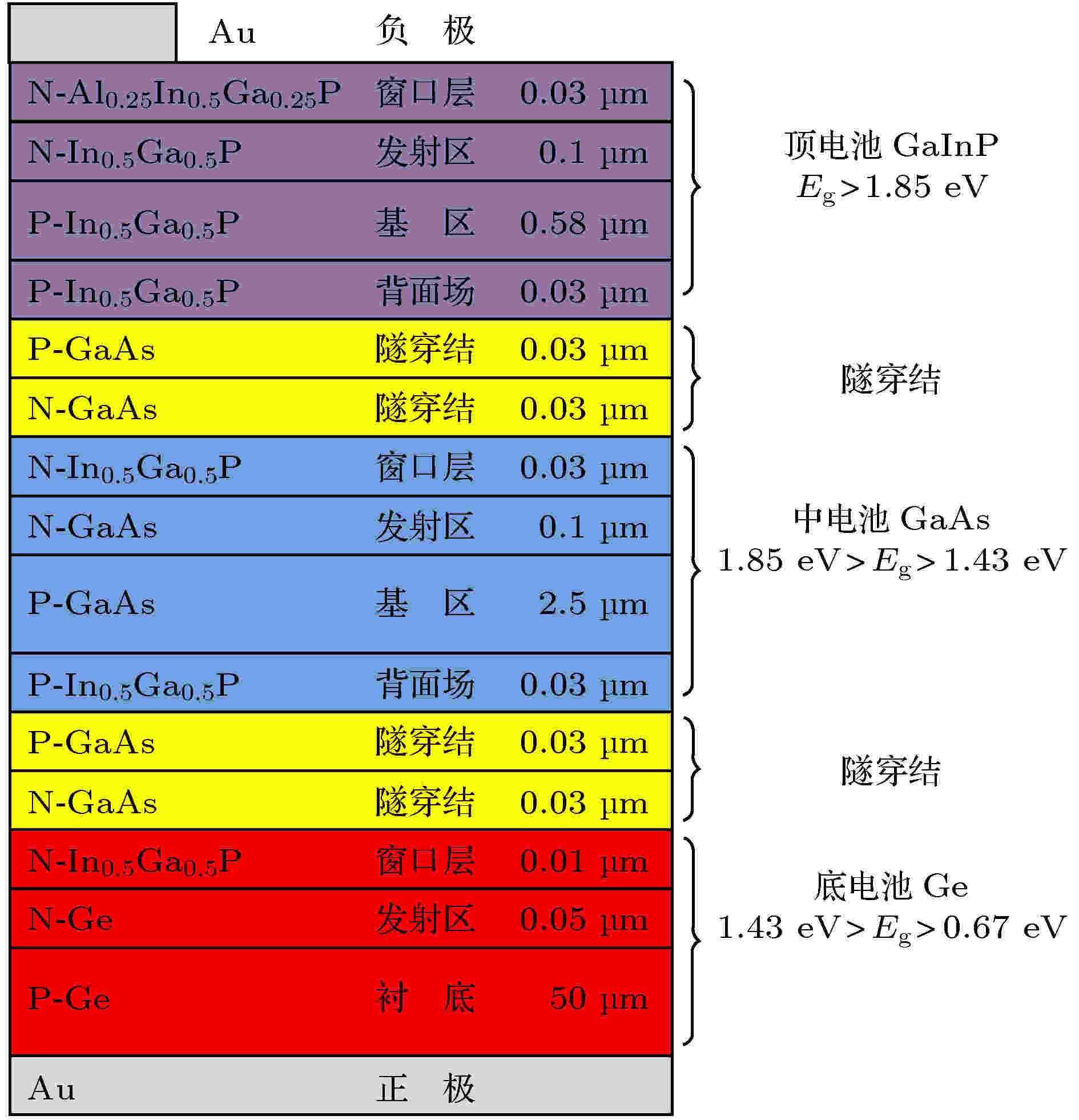
2020, 69 (9): 098802.
doi:10.7498/aps.69.20191878
Abstract +
PHYSICS OF GASES, PLASMAS, AND ELECTRIC DISCHARGES
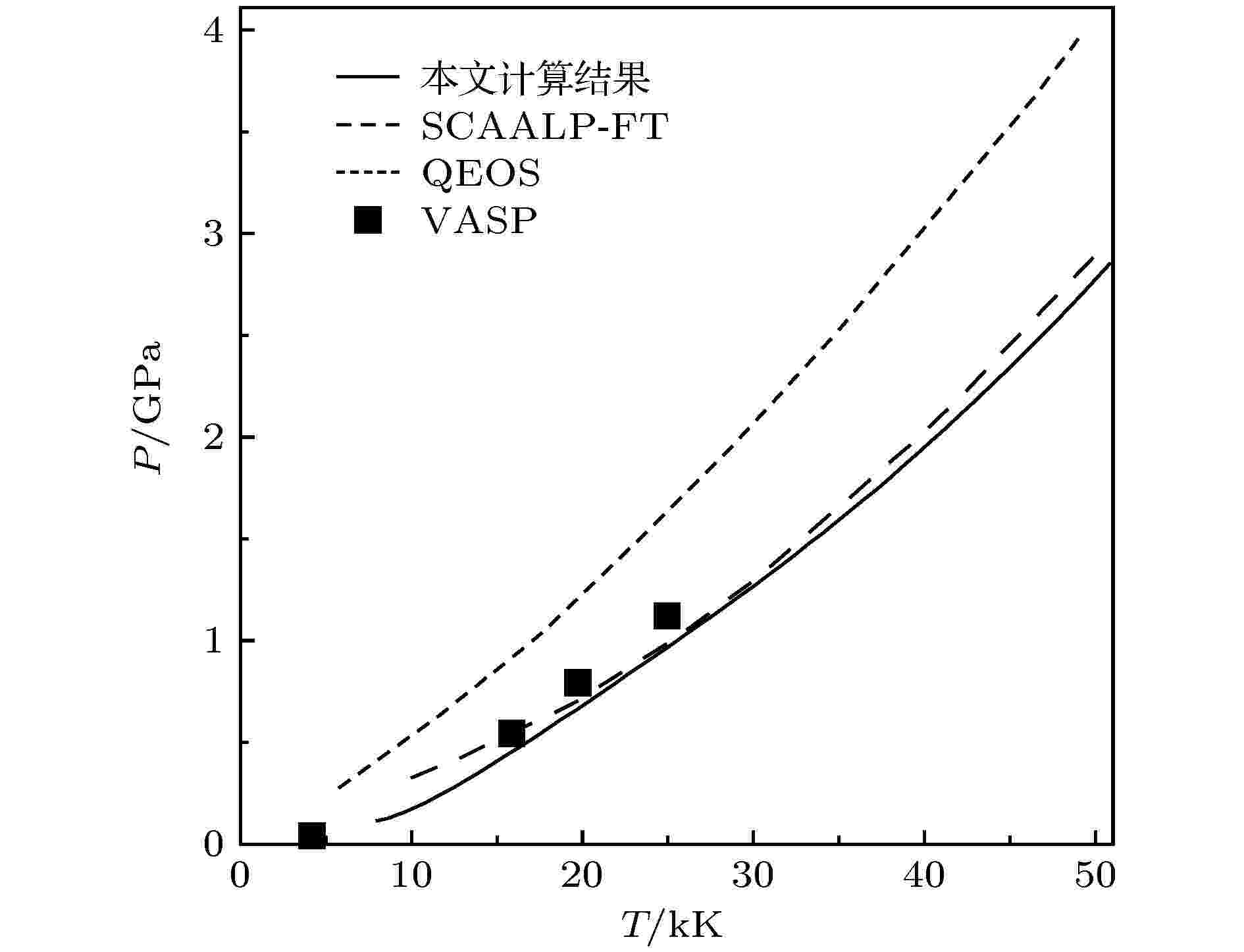
2020, 69 (9): 099101.
doi:10.7498/aps.69.20191826
Abstract +
Warm dense matter is widely found in the high-energy-density-physics researches, such as inertial confinement fusion, X-ray source and wire-array Z-pinch. The equation of state and ionization equilibrium of material in warm dense matter regime play a significant role in explaining experimental results and simulations of physical process. In this paper, the Coulomb interaction between charged particles, and the excluded volume effect due to high density and polarization effect between neutral atoms and charged particles are considered in the equation of state for aluminum in warm dense matter regime. A non-ideal Saha equation is used to account for the ionization equilibrium. The data for pressure and concentration of particles of aluminum plasma are derived by iteration between equation of state and ionization equilibrium model. The pressure and average ionization degree of aluminum plasma are consistent with the calculation results from other models and relevant experimental data. The Coulomb interaction, which dominants the non-ideal effects, is insensitive to temperature and increases with density rising especially near the region of critical density. The excluded volume effect peaks at a density of ~0.5 g/cm3. The polarization effect first becomes stronger with density increasing and then decreases at a density of ~0.4 g/cm3. The ionization equilibrium results with density ranging from 1.0 × 10–4g/cm3to 3.0 g/cm3and temperature ranging from 1.0 × 104K to 3.0 × 104K reveal that the average ionization degree increases with density sharply increasing near the critical density. The non-ideal effects, which lead the ionization energy to decline and the effective ionization potential of specific ions in aluminum plasma to decrease substantially, are responsible for the sharp increase of average ionization degree near the region of critical density. When the temperature is lower than 12000 K, first and second stage of ionization occur in aluminum plasma, and the system is mainly composed of Al1+, Al2+and electrons. The average ionization degree can reach 2 at critical density. The third stage of ionization is dominant in the aluminum plasma when plasma temperature is higher than 12000 K. And then, the charged particles in the plasma are composed of Al3+and electrons, allowing the average ionization degree to reach 3 at critical density.









